
| JAPANESE | TOP PAGE | |
|---|---|---|
| 0 | 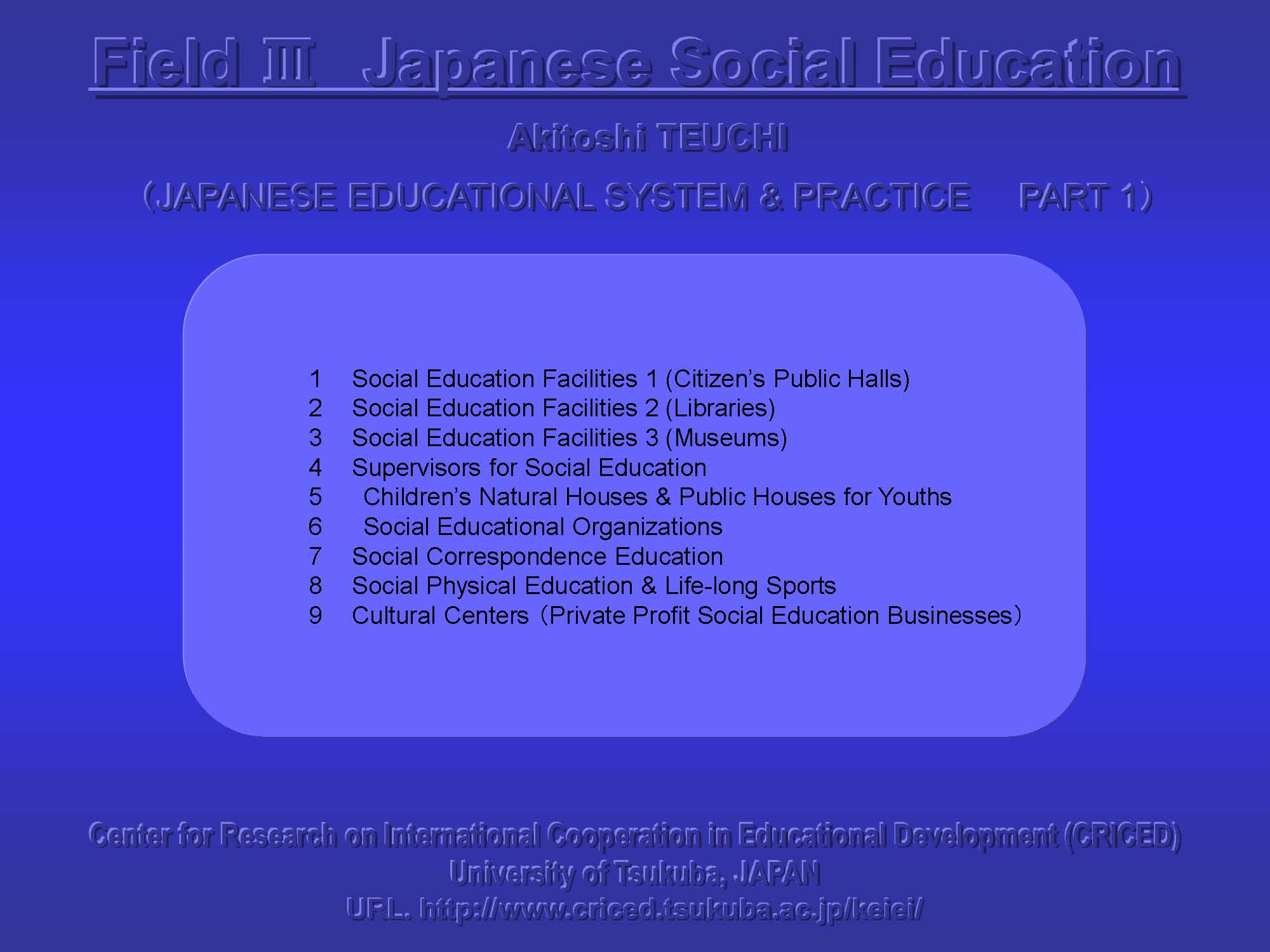 |
Download : III Japanese Social Education |
| 1 | 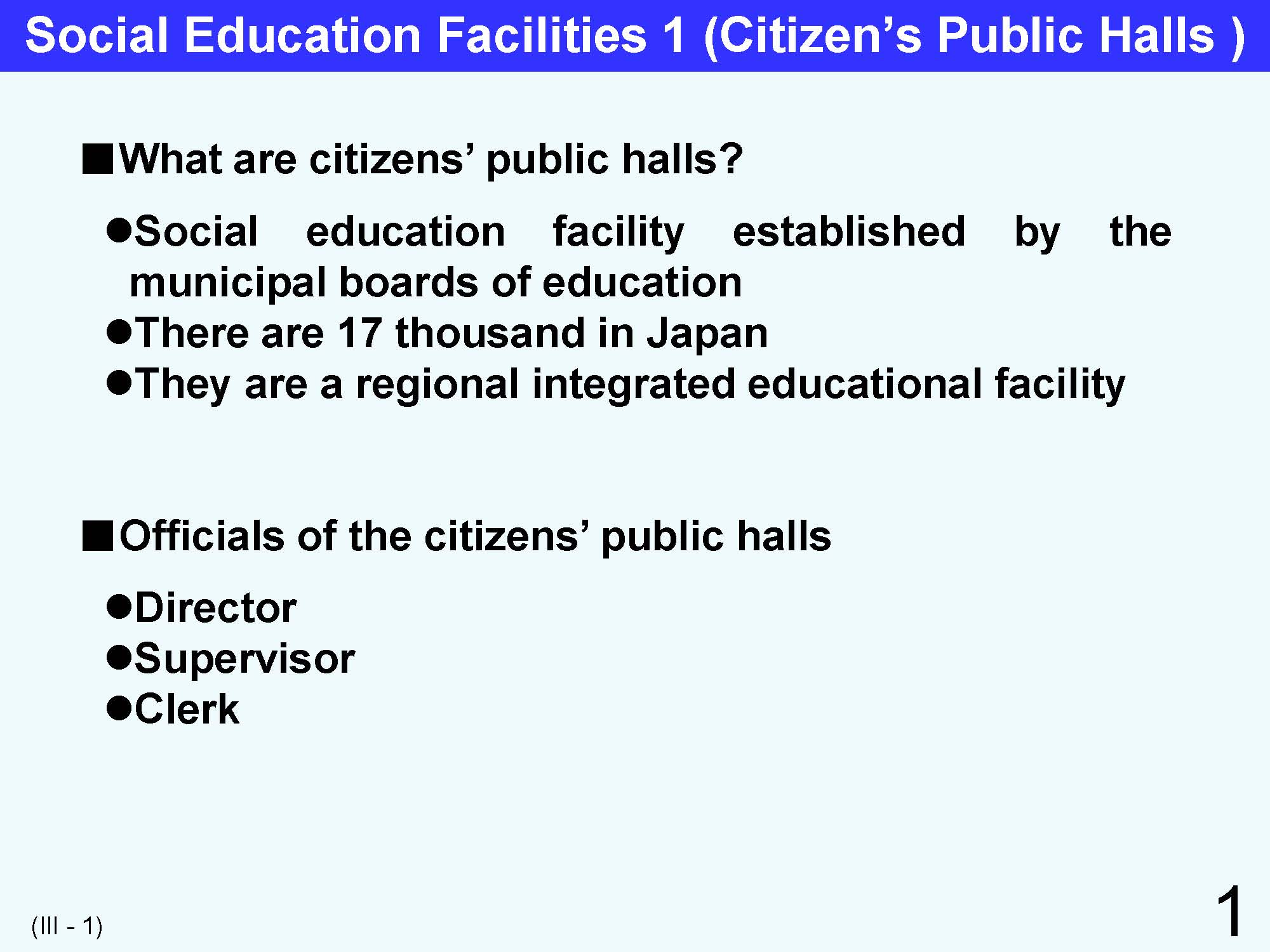 |
The citizens’ public halls (Kominkan) are an original social education facility in Japan. They were promoted in Japan through the “Establishment and Administration of citizens’ public halls,” that was based on a notice from a subordinate officer of the Ministry of Education in 1946. As the Social Education Law was enacted in 1949, citizens’ public halls (Kominkan) were registered as a social education facility established by municipalities. At present, there are 17,000 citizens’ public halls in Japan (Kominkan) whose form, scale and equipment are different. From the viewpoint of functions of citizens’ public halls, however, there are similarities. These halls function as a local comprehensive educational and cultural facility, and as a center for meeting, learning and social interactions for citizens. Full-time or part-time curators and citizens’ public hall officers are assigned to each citizens’ public hall (Kominkan). Social Education Officers qualify as citizens’ public hall (Kominkan) officers in some municipalities. There are also some citizens’ public halls to which clerks and part-time Social Education Leaders are assigned. |
| 2 | 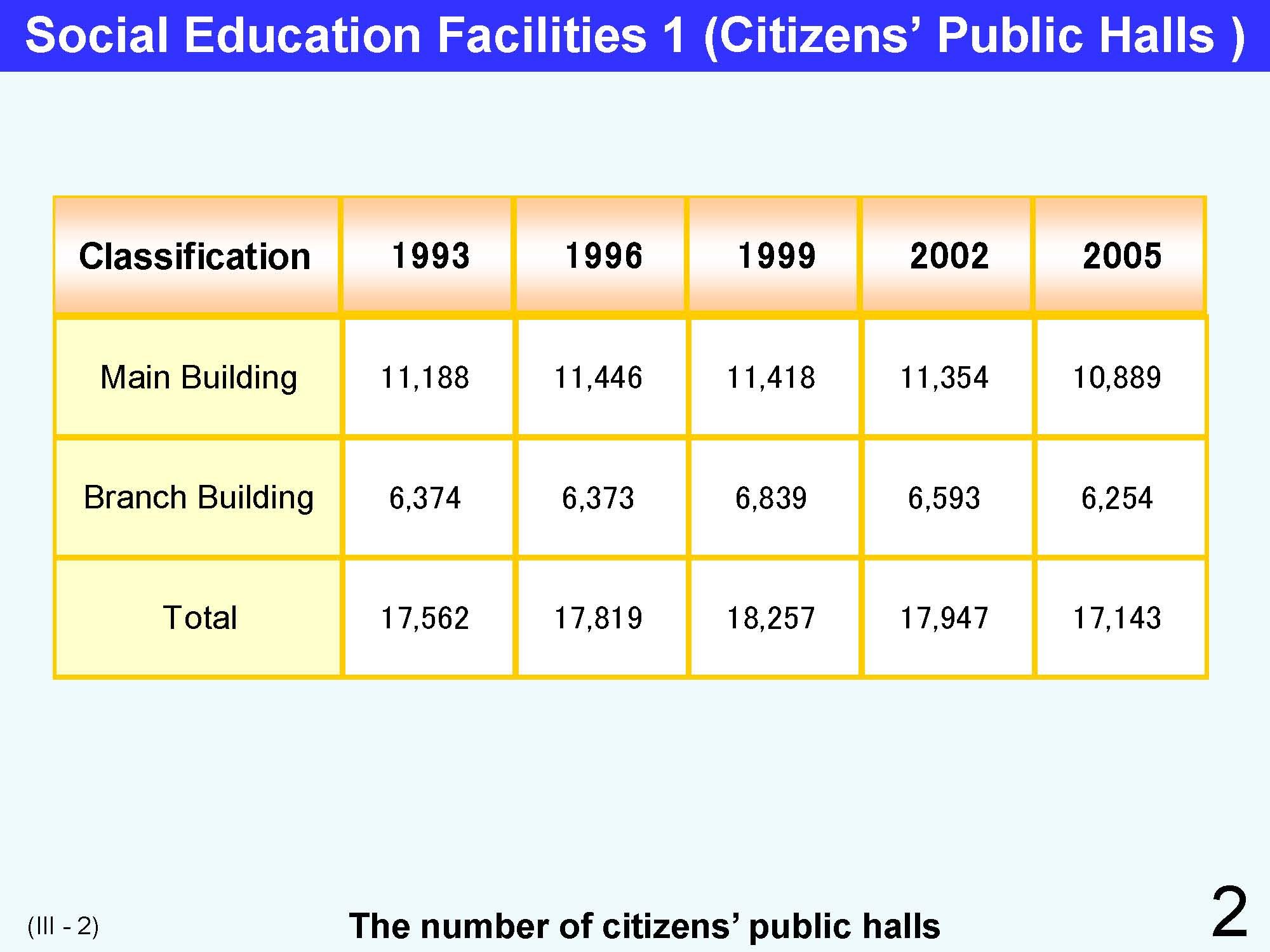 |
The total number of citizens’ public halls in Japan was approximately 17,000 in 2005, and the percentage of municipalities with citizens’ halls was 89.1%. There were approximately 52,000 personnel (total of full-time, concurrent, and part-time staff members) who worked for citizens’ public halls in 2005. Among them, 17,000 supervisors of citizens’ public halls played a leading role. The number of citizens’ public halls established in Japan is higher than the number of museums (approximately 1,200) and libraries (approximately 3,000) in terms of Japan’s social education facilities. The number is larger than that for lower secondary schools, and smaller than that for elementary schools. Citizens’ public halls are the closest to local communities in Japan’s social education facilities. |
| 3 | 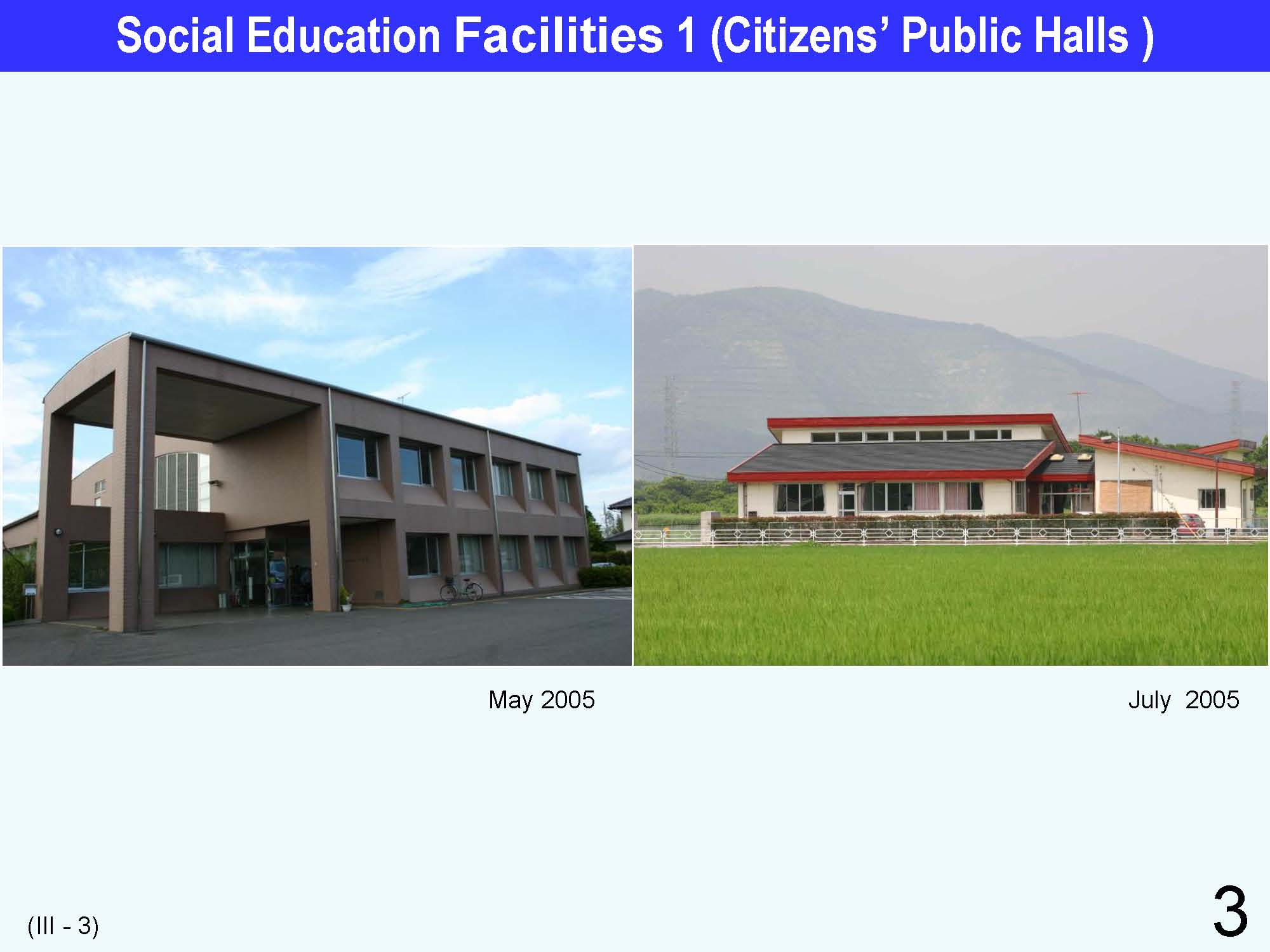 |
Civic citizens’ public halls |
| 4 | 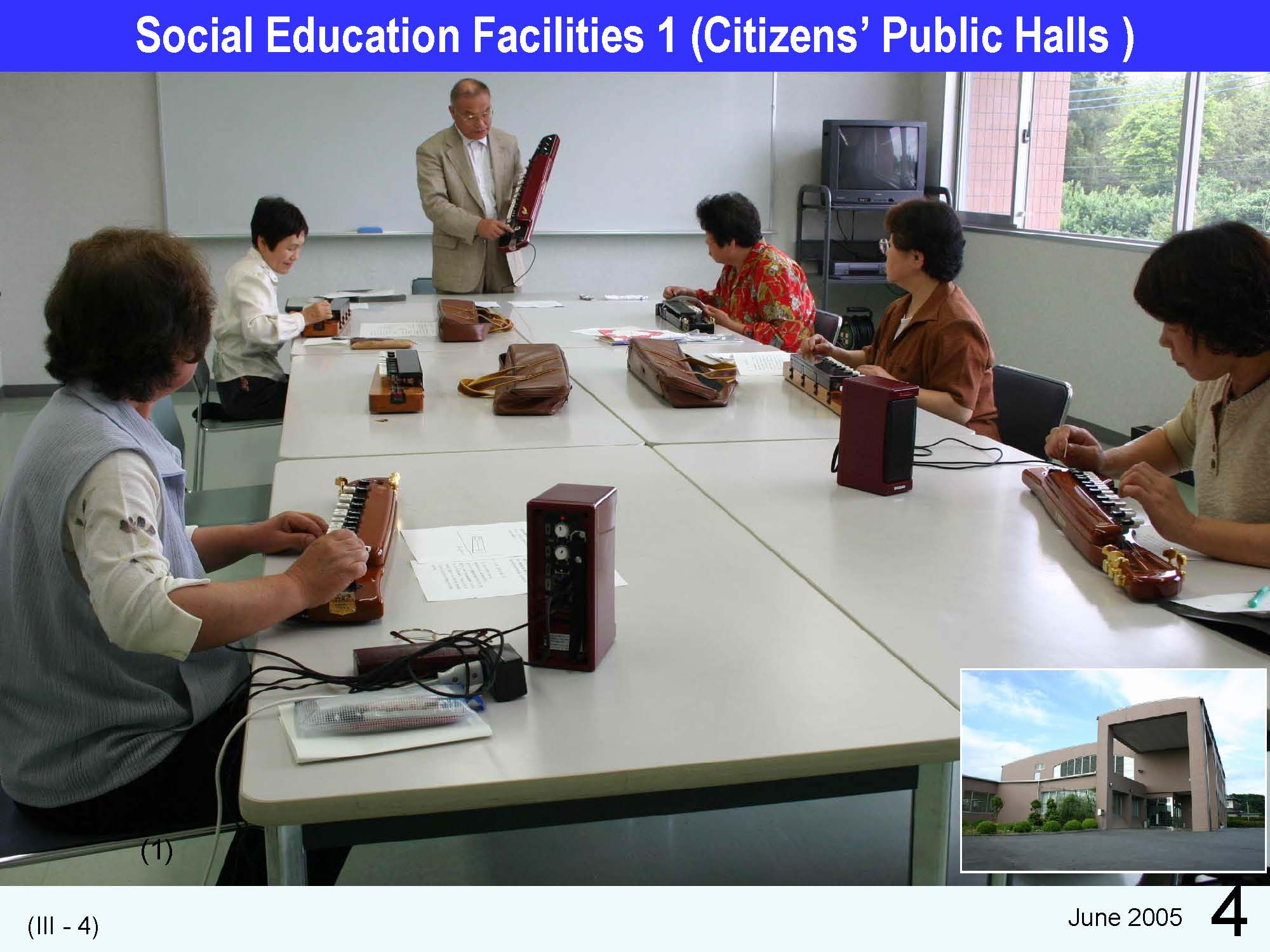 |
Citizens’ public halls conduct various activities related to meeting, learning and gathering of people within communities given their function as municipality social education institutions. They arrange classes and courses to offer opportunities for self-development. Among the classes and courses they offer, there are culture-oriented programs, sport recreation, skill development courses for daily life and courses to learn about the local community in order to deepen understanding of it. In addition, citizens’ public halls provide places and rooms for independent group or club activities for communities, and are utilized as venues for various events and meetings of the community. (1) Taisho-goto (Japanese modern harp) course |
| 5 | 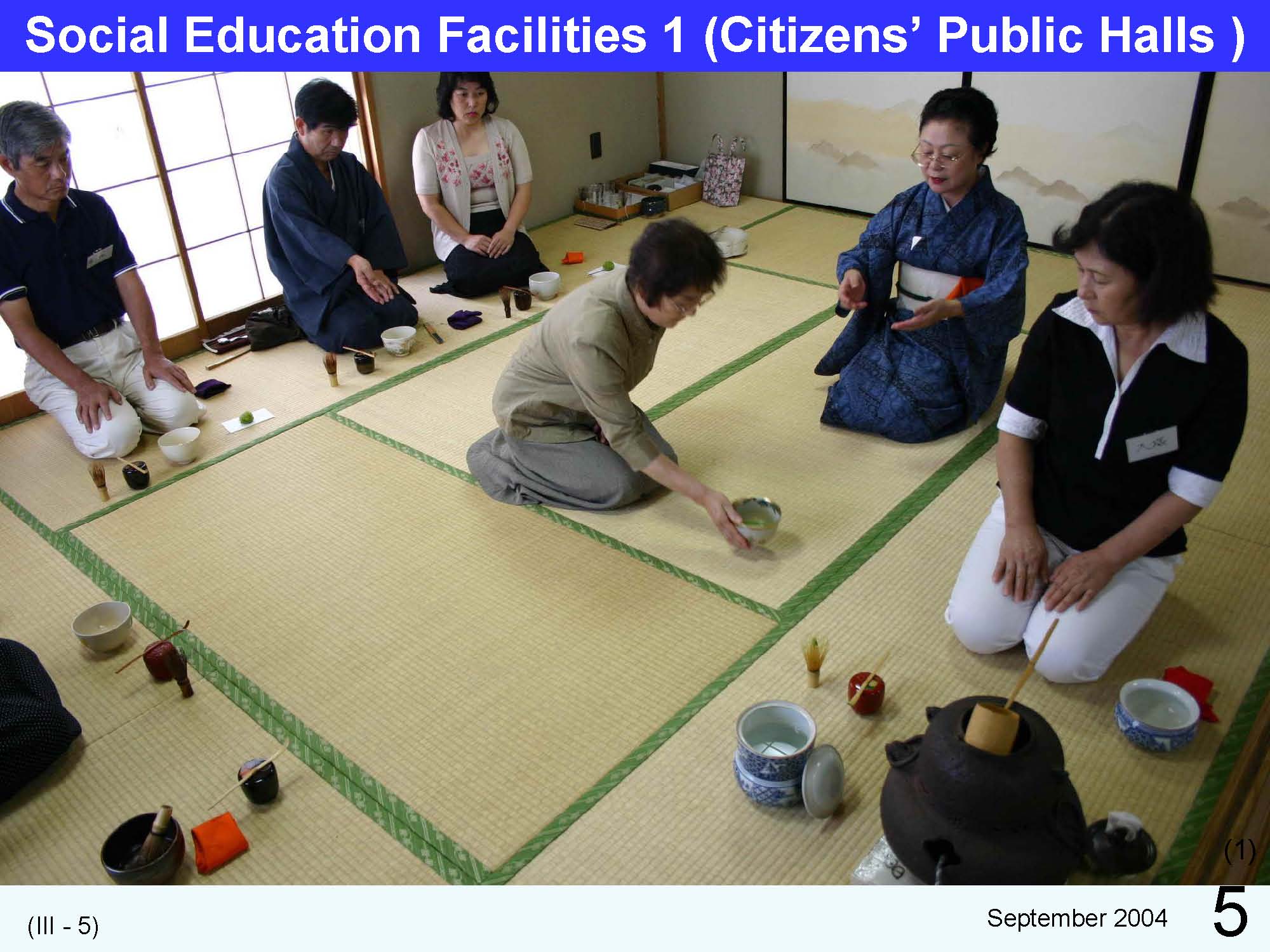 |
Citizens’ public halls conduct various activities related to meeting, learning and gathering of people within communities given their function as municipality social education institutions. They arrange classes and courses to offer opportunities for self-development. Among the classes and courses they offer, there are culture-oriented programs, sport recreation, skill development courses for daily life and courses to learn about the local community in order to deepen understanding of it. In addition, citizens’ public halls provide places and rooms for independent group or club activities for communities, and are utilized as venues for various events and meetings of the community. (1) Sado (tea ceremony) course |
| 6 | 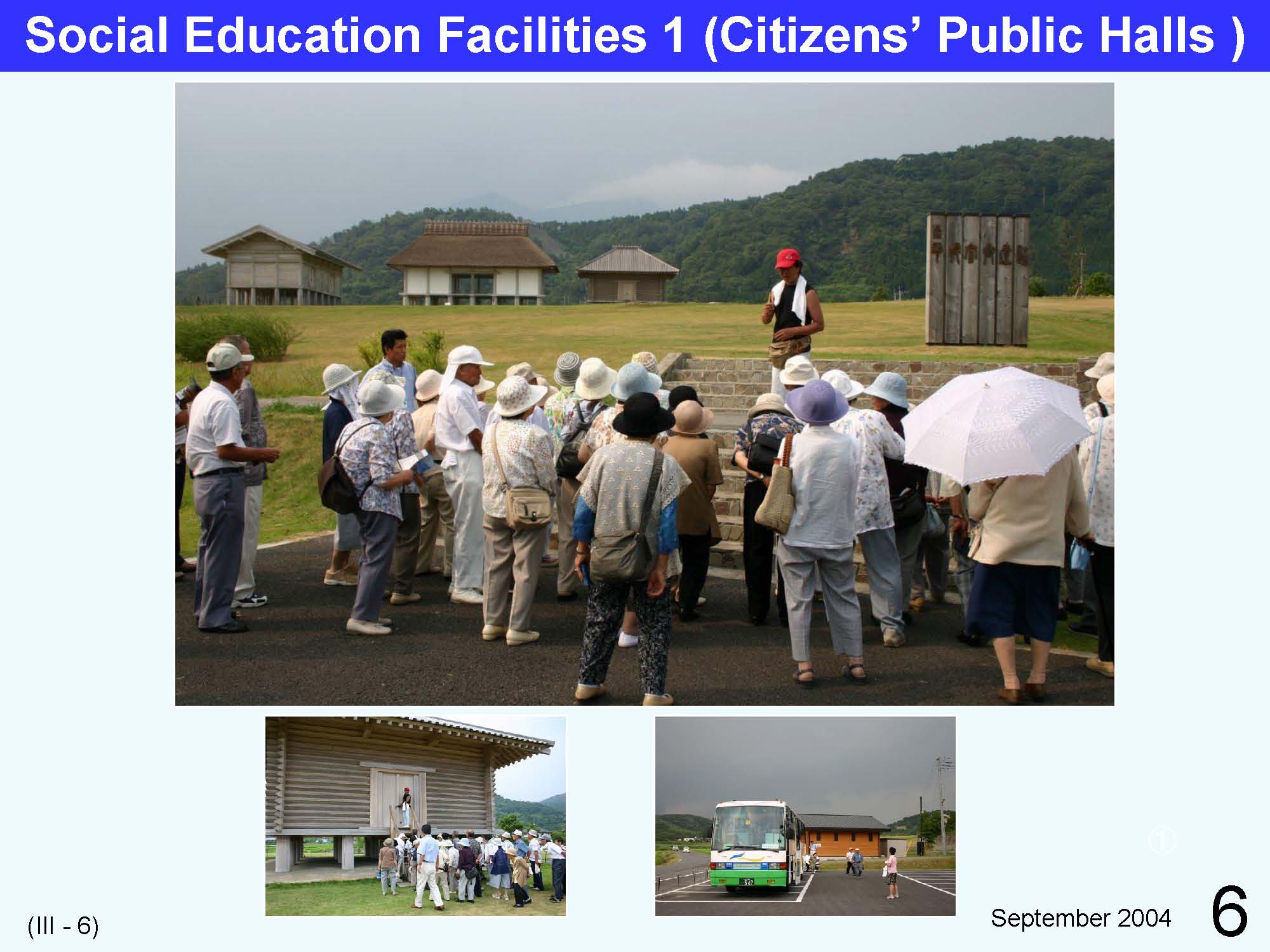 |
Citizens’ public halls conduct various activities related to meeting, learning and gathering of people within communities given their function as municipality social education institutions. They arrange classes and courses to offer opportunities for self-development. Among the classes and courses they offer, there are culture-oriented programs, sport recreation, skill development courses for daily life and courses to learn about the local community in order to deepen understanding of it. In addition, citizens’ public halls provide places and rooms for independent group or club activities for communities, and are utilized as venues for various events and meetings of the community. Picture: senior citizens are visiting the relics of a city. The instructor with a red cap is a retired school teacher. This program is named “longevity university”. (1) Study tour to visit the relics in the city |
| 7 | 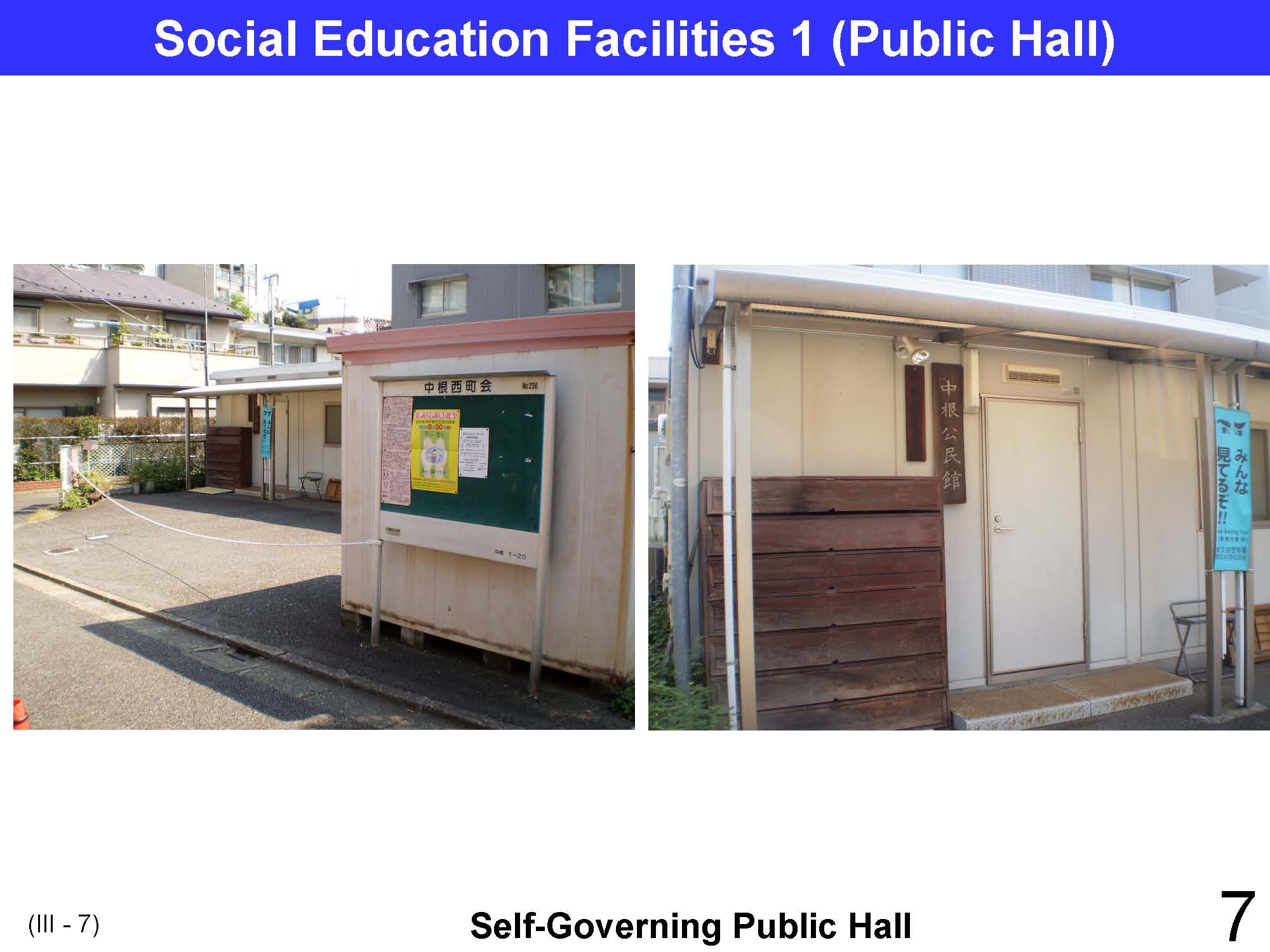 |
In local communities, there are community-governing assembly facilities like so-called “self-governing public halls,” “village-governing public halls,” and “town-governing public halls” that are funded by community associations or neighborhood associations and managed and operated on an autonomous basis, as well as “ordinance public halls” based on establishment ordinance by educational boards of municipalities. Intensive surveys on the number of community-governing assembly facilities of this type have not been conducted nationwide. According to the survey conducted by the National Kominkan Association in November 2002, there are 76,883 public halls in total across the nation. |
| 8 | 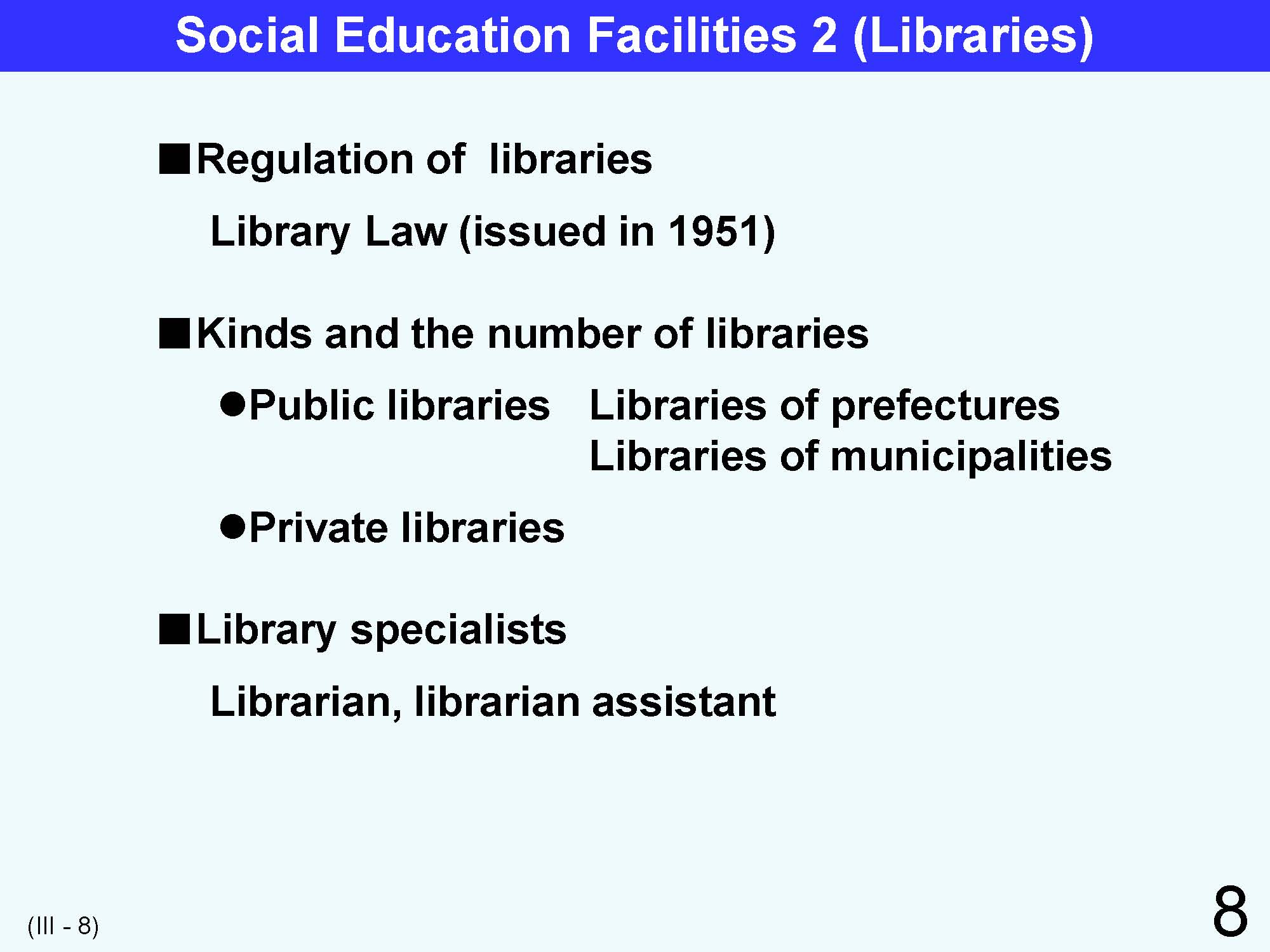 |
Under the Library Law enacted in 1951, a “library” is defined as an institution whose objective is to collect books, records and other necessary materials, to assemble and preserve them, and to make them available for public use so that they can contribute to culture, research and recreation of the people. Also under the law, libraries are divided into two categories according to how they are established. It defines public libraries as those established by a prefecture or a municipality, and private libraries as those established by private entities such as the Japanese Red Cross or corporations defined under Article 34, the Civil Law. In terms of the numbers of libraries established, more than 90% of all the libraries are public libraries. Specialists assigned to libraries are librarians and librarian assistants. |
| 9 | 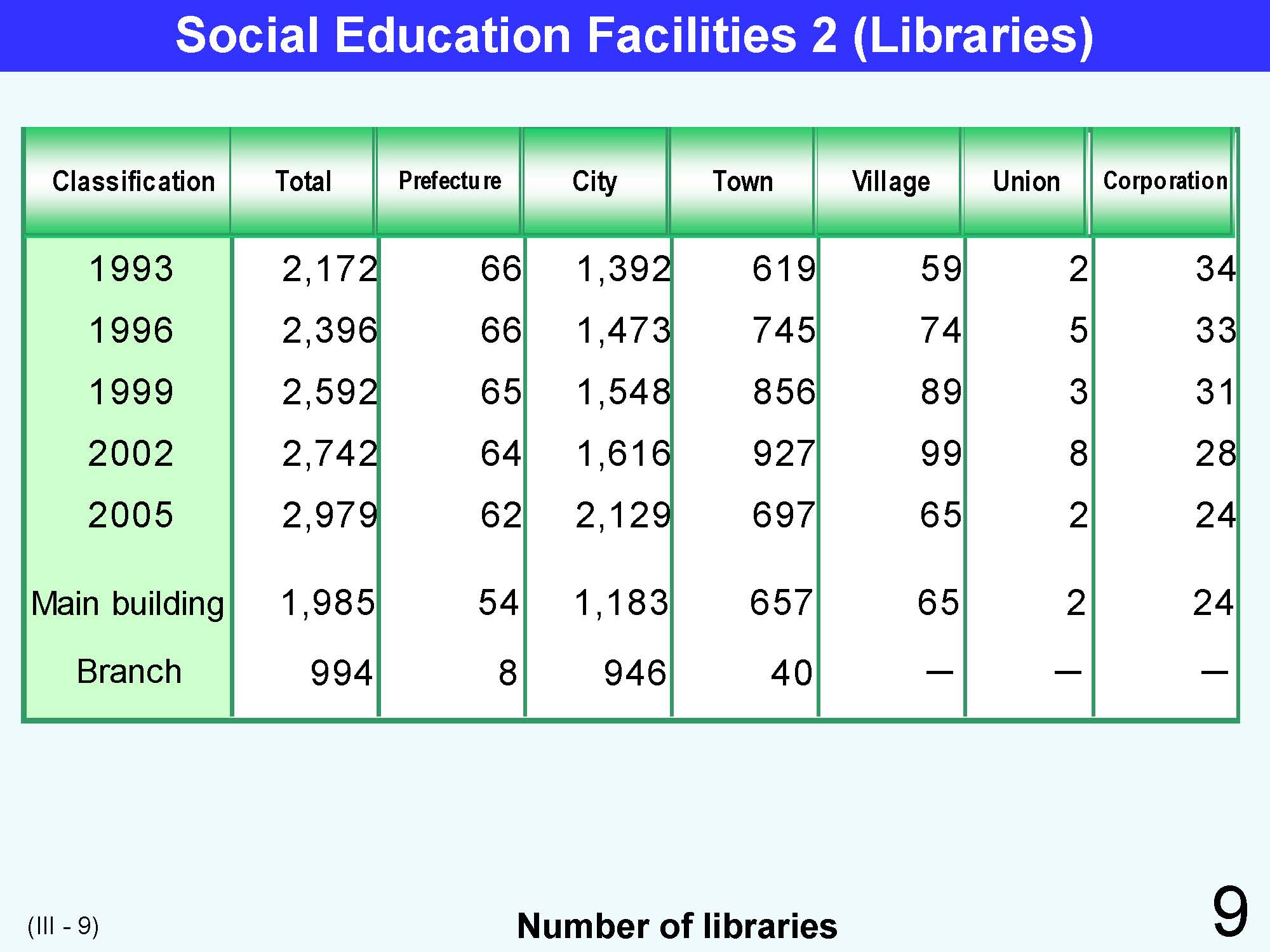 |
By the year 2005, around 3,000 libraries (main buildings and branches) had been established in Japan. Of those 3,000, 62 libraries were established by prefectures. Since Japan has 47 prefectures, this means there are 1.3 prefecture libraries per prefecture on the average. On the other hand, since there are about 1,779 municipalities (as of March 31st, 2009), the number of libraries established by municipalities averages 1.6 per municipality. |
| 10 | 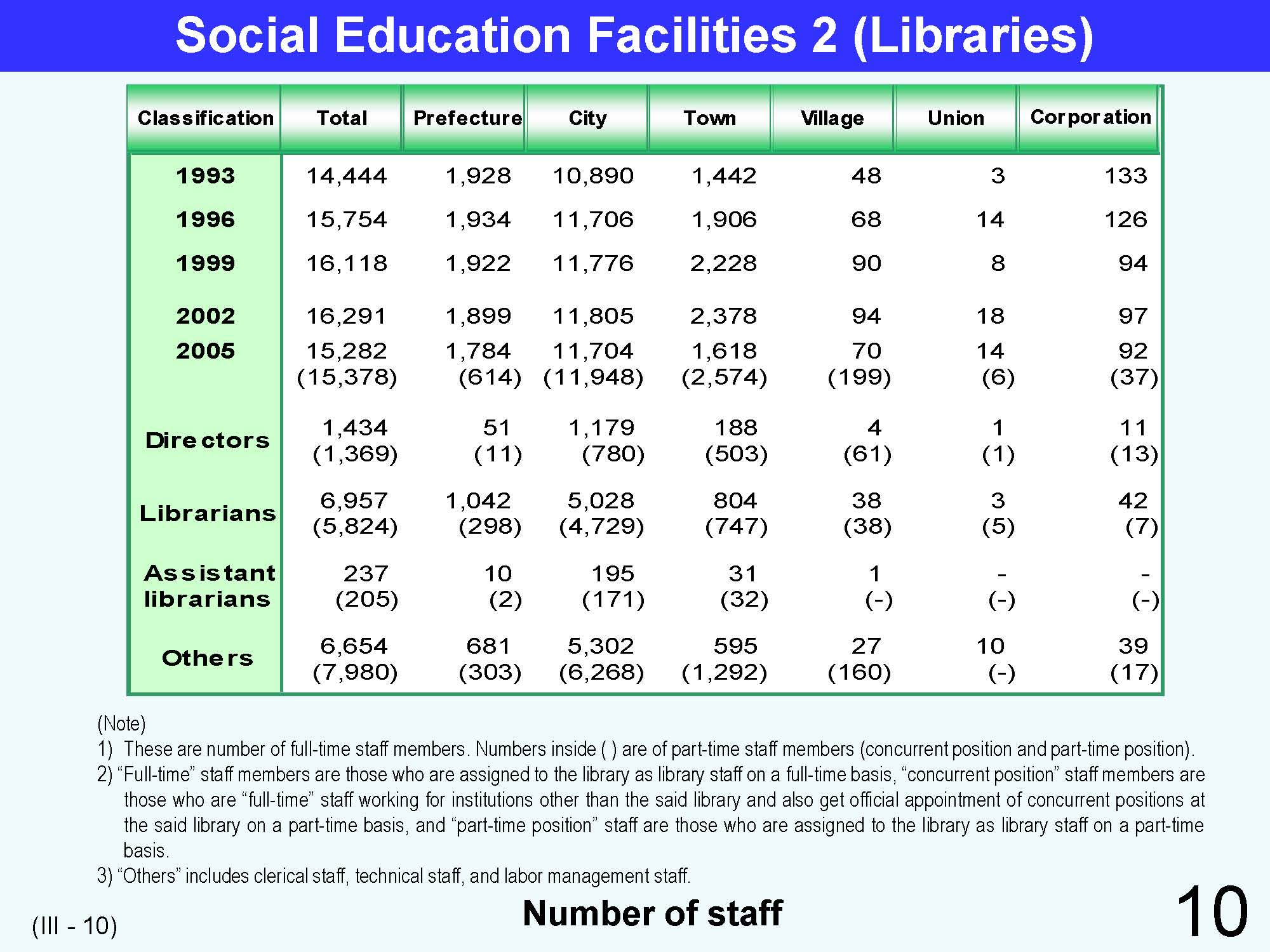 |
As for the number of full-time library staff, about 5.1 people work at a library on average. In terms of administrative levels of municipalities, differences in the number of staff assigned to libraries are recognizable. For libraries set up by prefectures, there are about 28.8 staff each, whereas for libraries set up by cities, the figure is around 5.5 staff, and for libraries set up by towns or villages, the average goes down to around 2.2. There is a gap between differing administrative levels of municipalities in the provision of public libraries in Japan. Libraries cannot operate with full-time staffs alone and they are maintained by concurrent position staffs and part-time position staffs as well. |
| 11 | 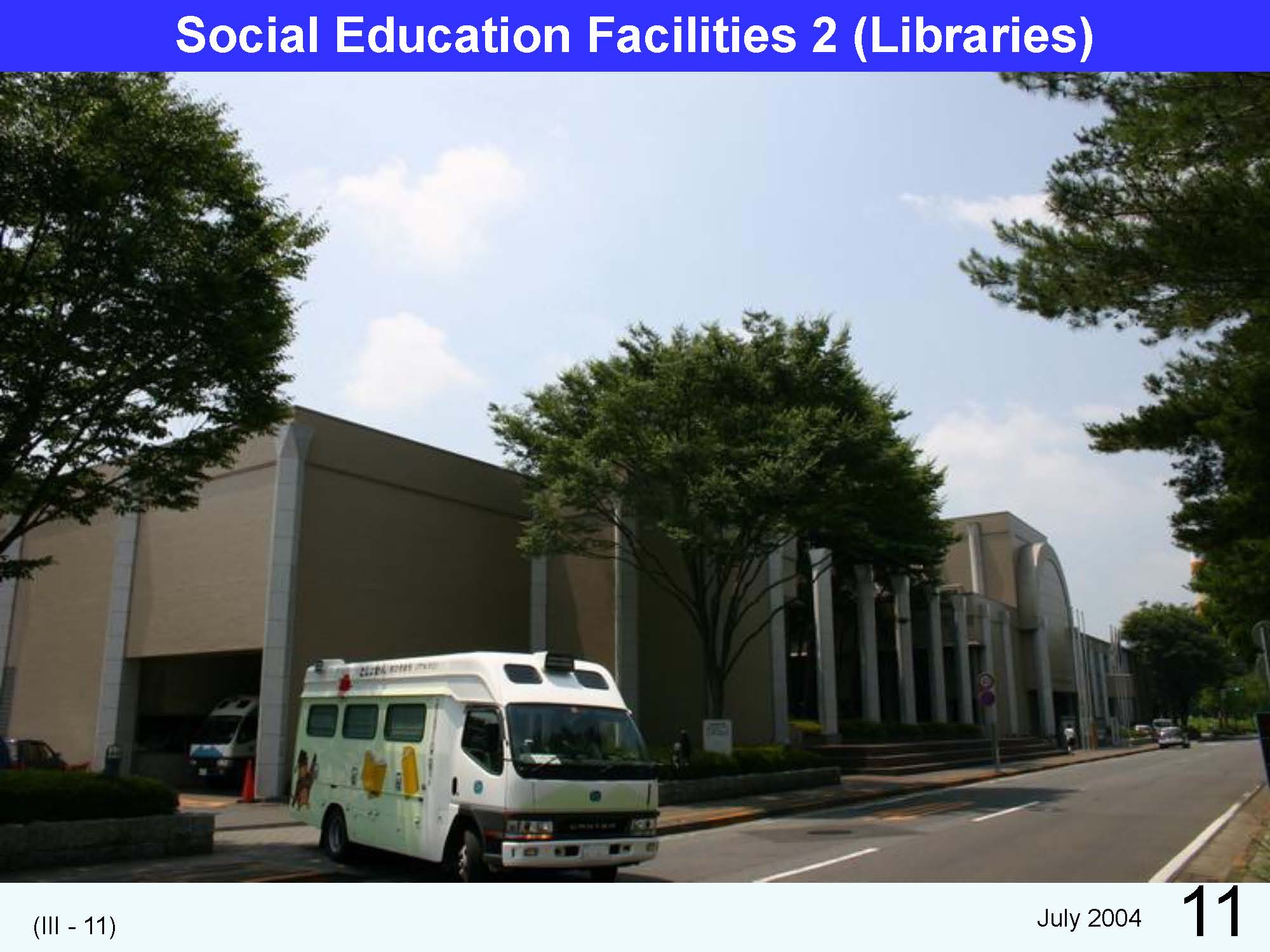 |
The building of a civic library |
| 12 | 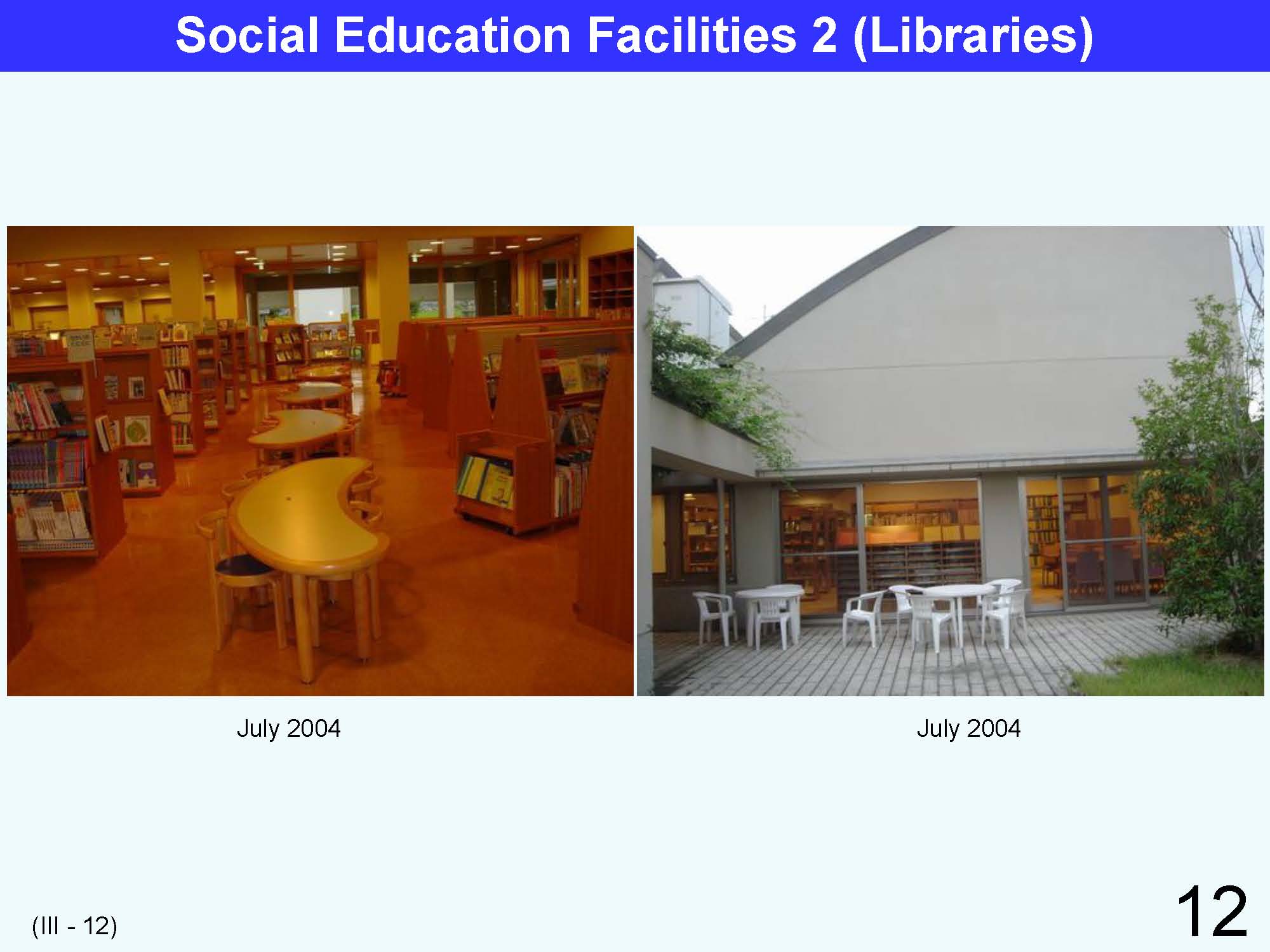 |
As prescribed in the Library Law, libraries collect mainly books to be used by local people in order to cultivate their minds, as well as for research recreation. Needless to say, with possessions of numerous materials, such as books, it is important as well as necessary for libraries to have facilities where people can study comfortably and engage in recreation. Picture: facilities in a library. |
| 13 | 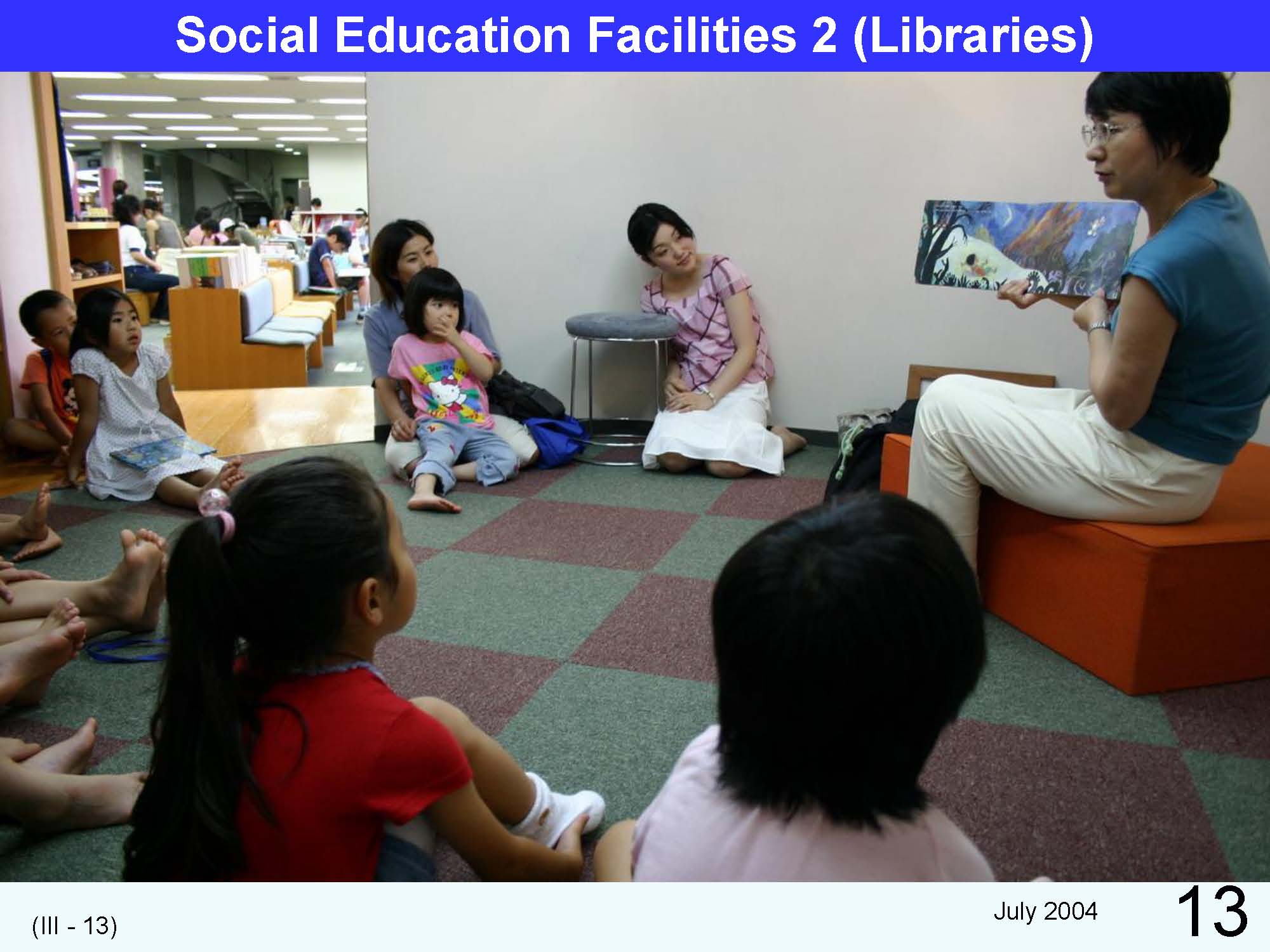 |
As prescribed in the Library Law, libraries collect mainly books to be used by local people in order to cultivate their minds, as well as for research recreation. Needless to say, with possessions of numerous materials, such as books, it is important as well as necessary for libraries to have facilities where people can study comfortably and engage in recreation. In addition, libraries have outreach program, for example, reading stories for children. Members of a civic voluntary group registered at a library are reading a picture book in a room at the library in the above photograph. |
| 14 | 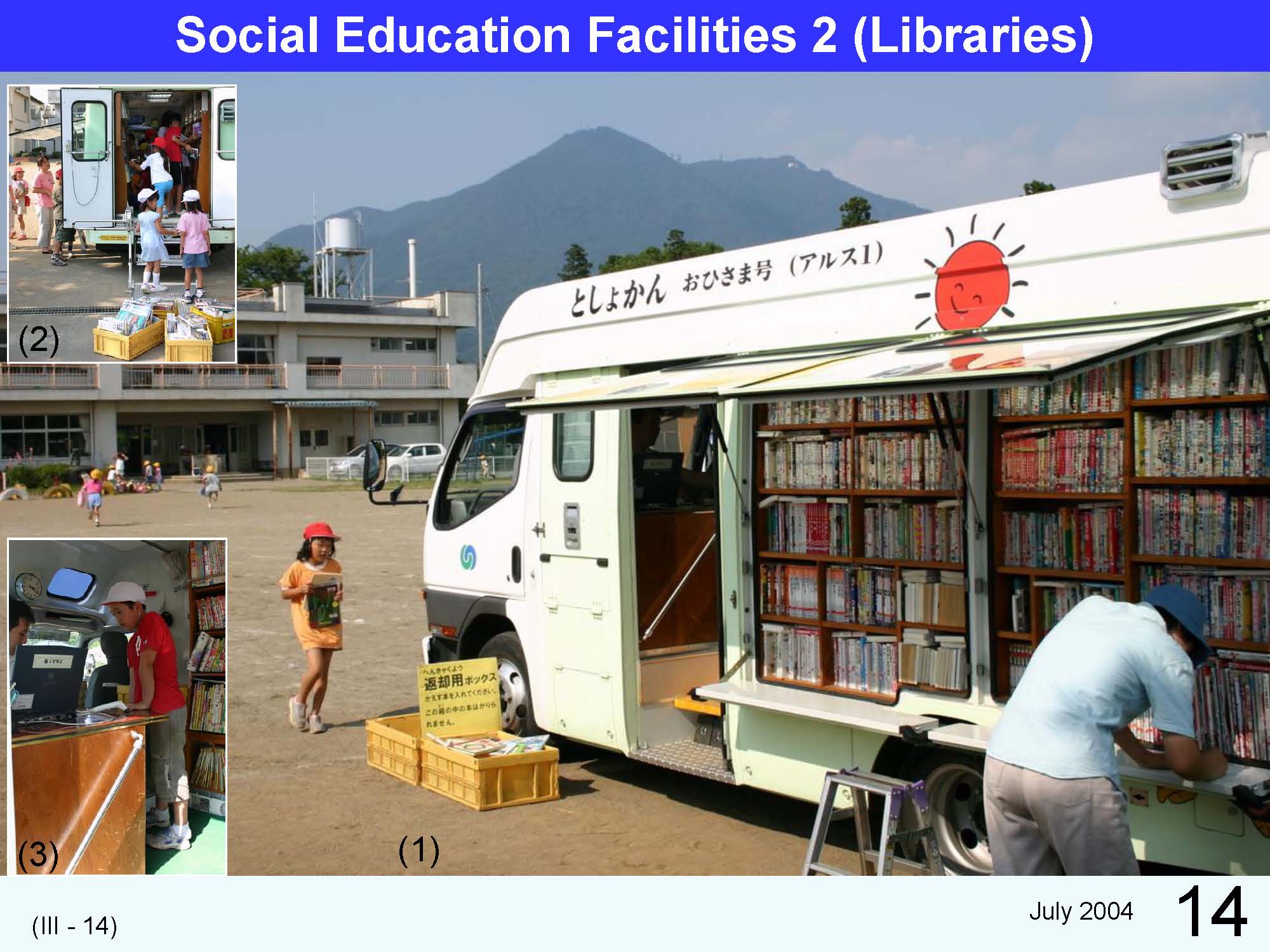 |
As prescribed in the Library Law, libraries collect mainly books to be used by local people in order to cultivate their minds, as well as for research recreation. Needless to say, with possessions of numerous materials, such as books, it is important as well as necessary for libraries to have facilities where people can study comfortably and engage in recreation. In addition, libraries have other outreach programs, for example operating mobile libraries that are for people who cannot come to the library because of geographic or life conditions. The municipal library in the above picture owns two mobile libraries that visit 48 fixed places in the city twice a month, hauling about 3,000 books. (1) A mobile library car stopped at an elementary school. (2) A mobile library car carries about 3,000 books. (3) Books are operated with a computer. |
| 15 | 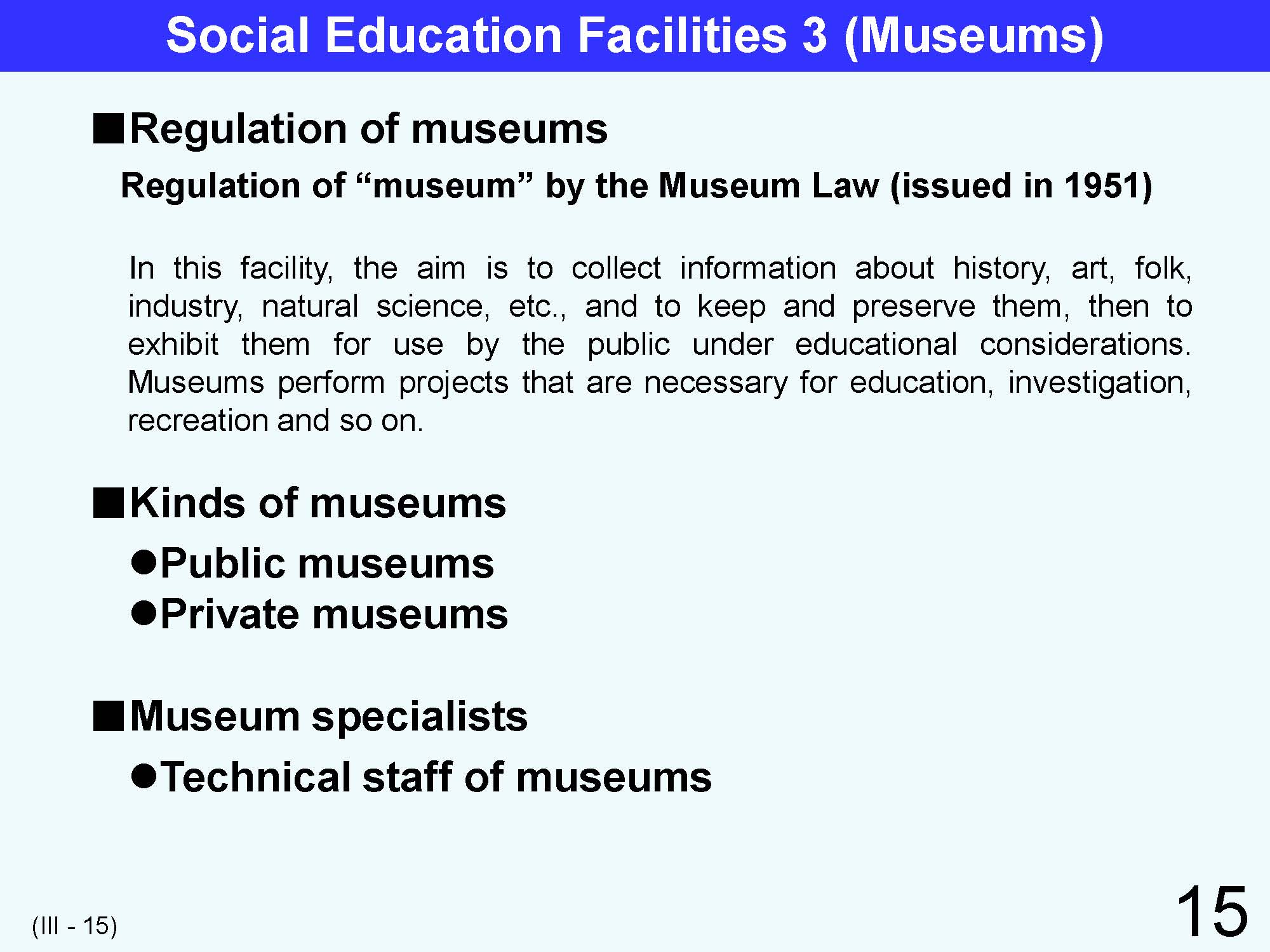 |
Under the Museum Law enacted in 1951, a “museum” is defined as an institution whose objective is to collect materials related to history, art, folklore, industry and natural science, to preserve and to display them, and then to make them available to the public for educational use so that the museums can contribute to local culture, research and recreation of the local community, and also to provide opportunities for research on collected materials. Under the law, public museums are those established by prefectures or municipalities while private museums are those established by corporations defined under Article 34 of the Civil Law including religious corporations. Specialists assigned to museums are curators. |
| 16 | 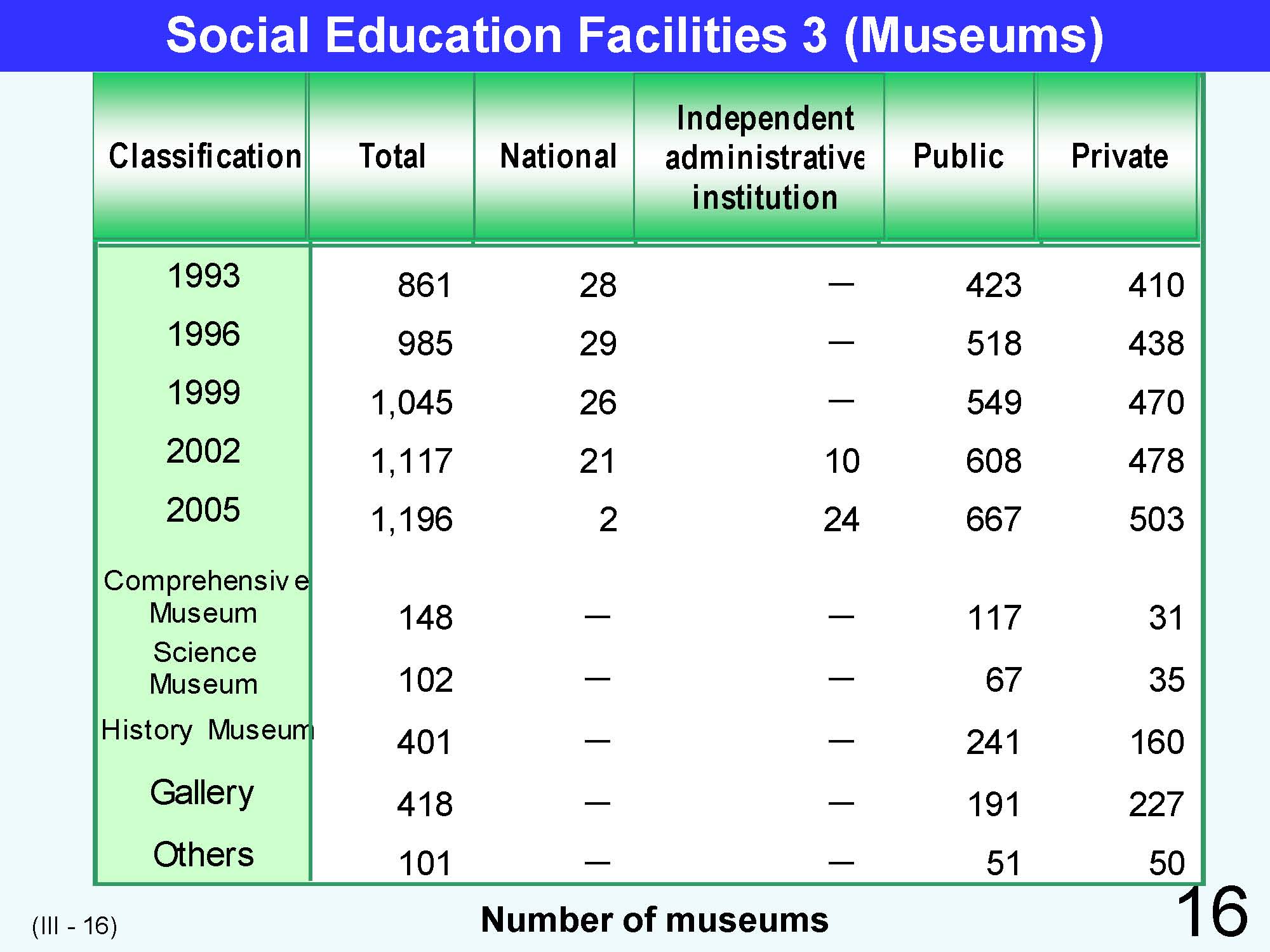 |
Excluding national museums and independent administrative institutions, there were 1,170 museums and museum-equivalent institutions in Japan as of 2005, including both public and private museums which are registered under the Museum Law. On the average, there are about 25 museums per prefecture. |
| 17 | 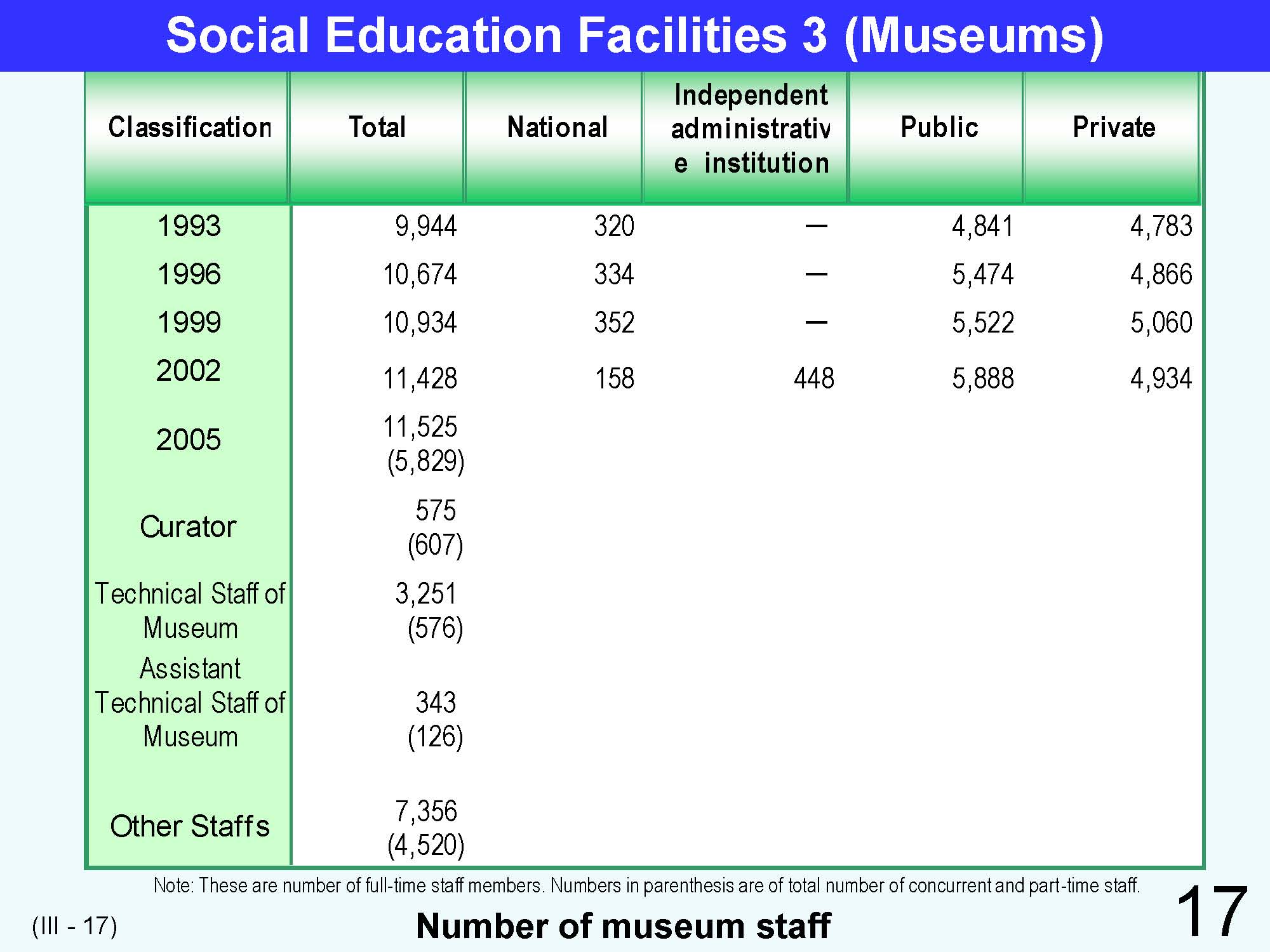 |
About 10 staff are assigned to each museum in the year 1999. |
| 18 | 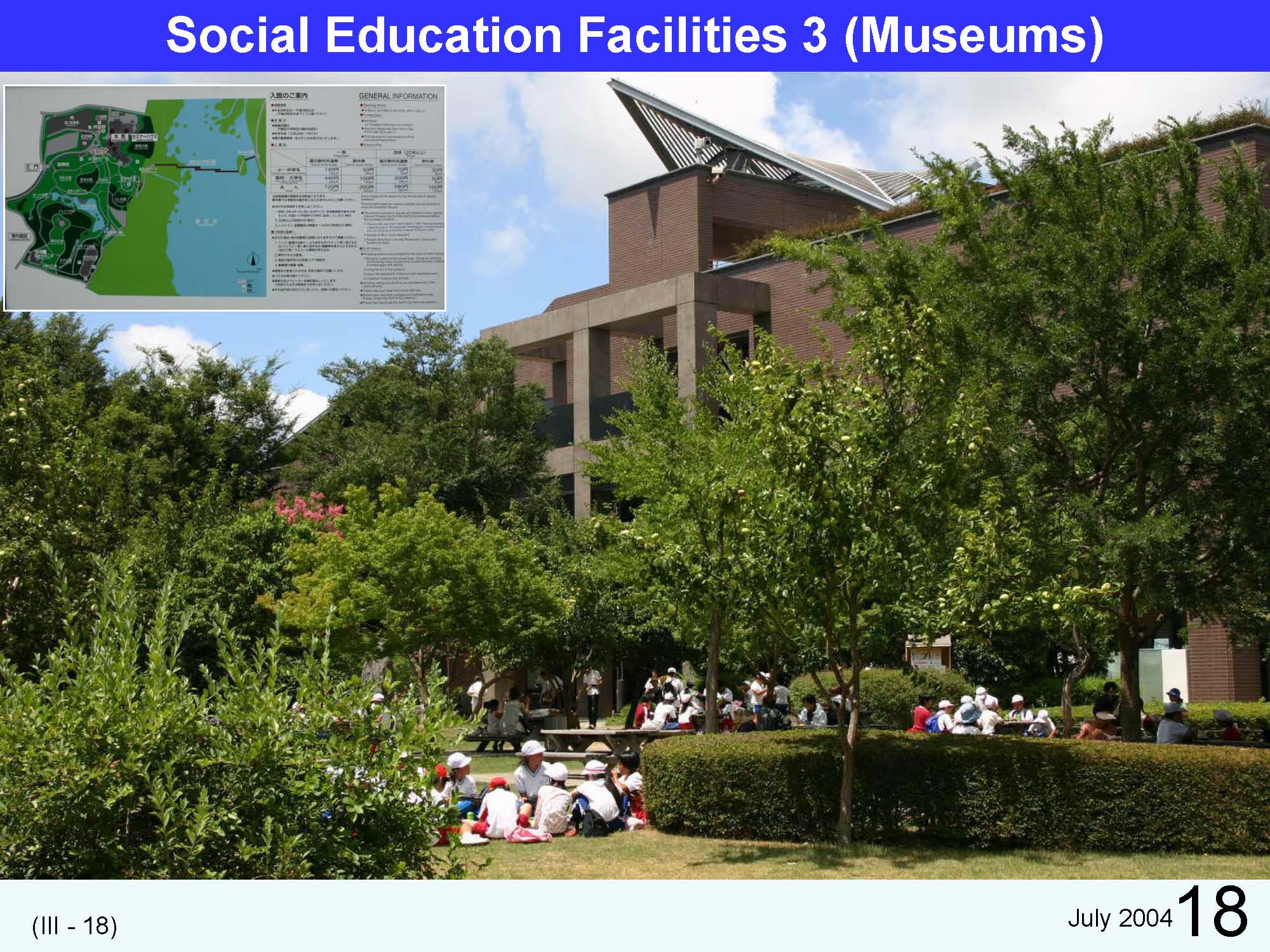 |
A prefectural natural museum building. |
| 19 | 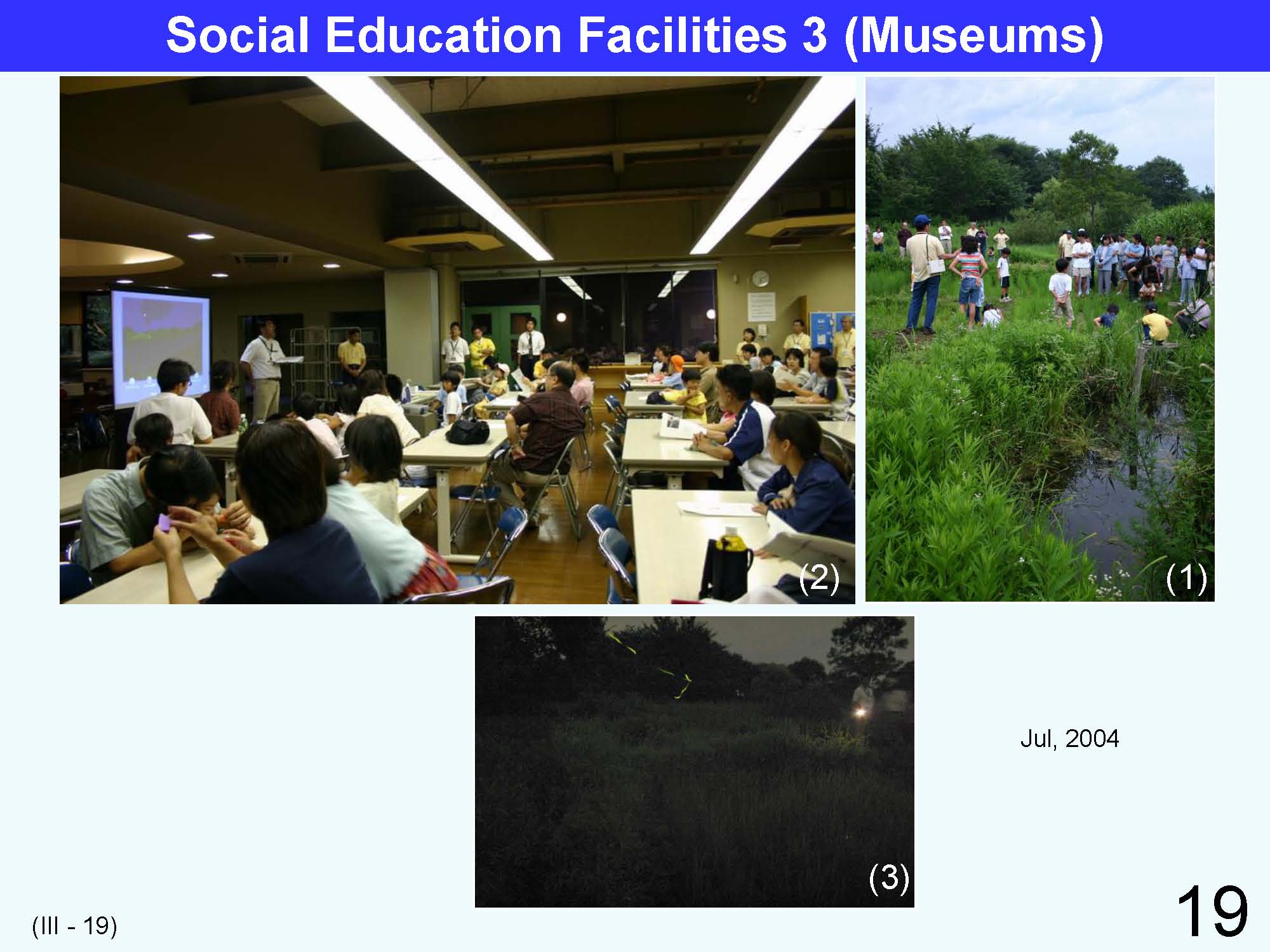 |
A natural museum offers various courses. This is a family nature observation course titled “Let’s watch the natural environment with fireflies”. (1) Visiting a pool and observing the environment. The pool is located on the natural museum’s premises. (2) Listening to a lecture about fireflies. (3) Observing fireflies after dark. |
| 20 | 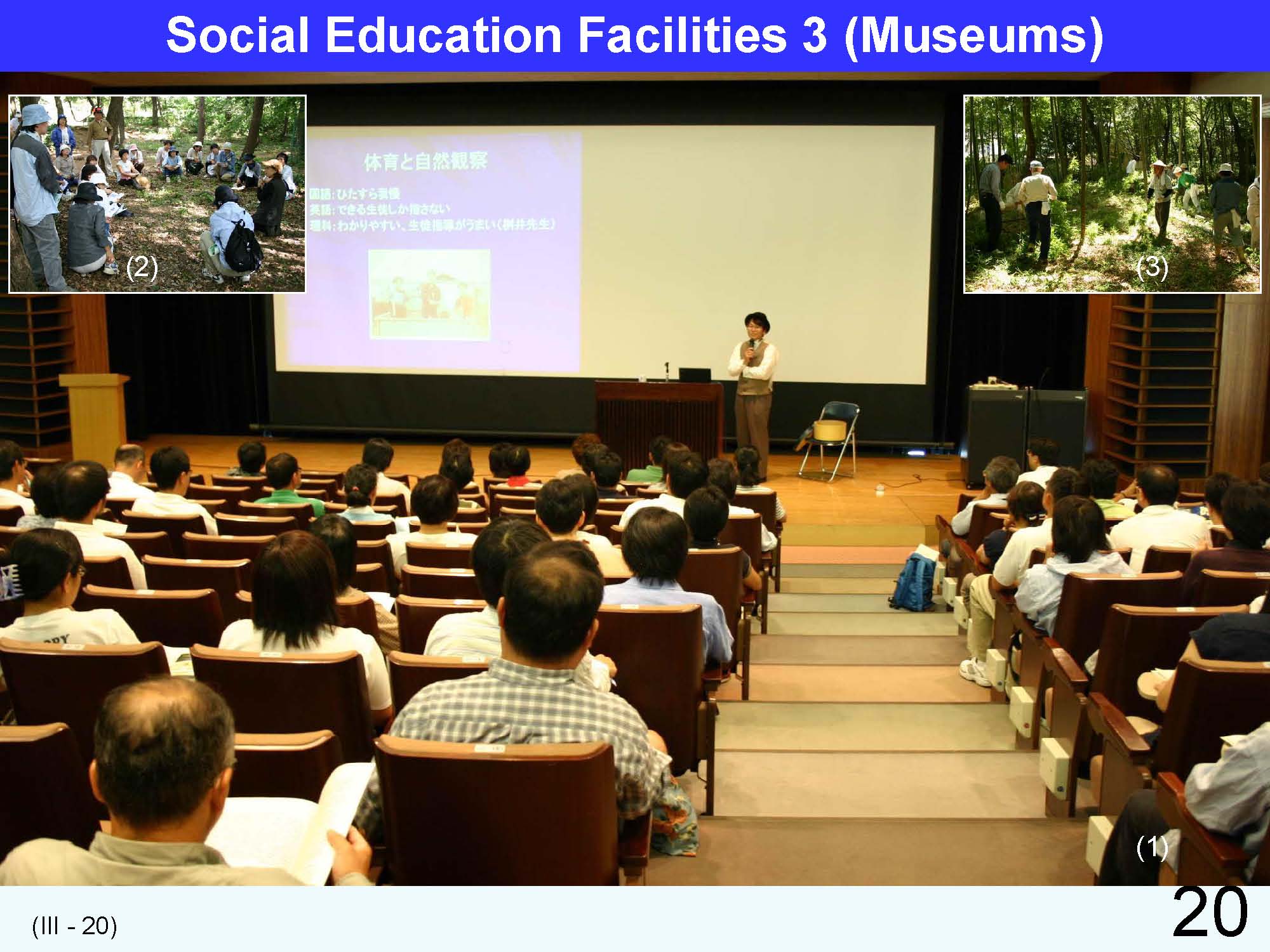 |
A natural museum offers various courses. This is an in-service training course for teachers titled “the integrated science education utilizing nature at hand”. (1) The keynote speech (2) Workshop in a forest: listening to sounds of nature (3) Workshop in a bamboo forest: making bamboo charcoals |
| 21 | 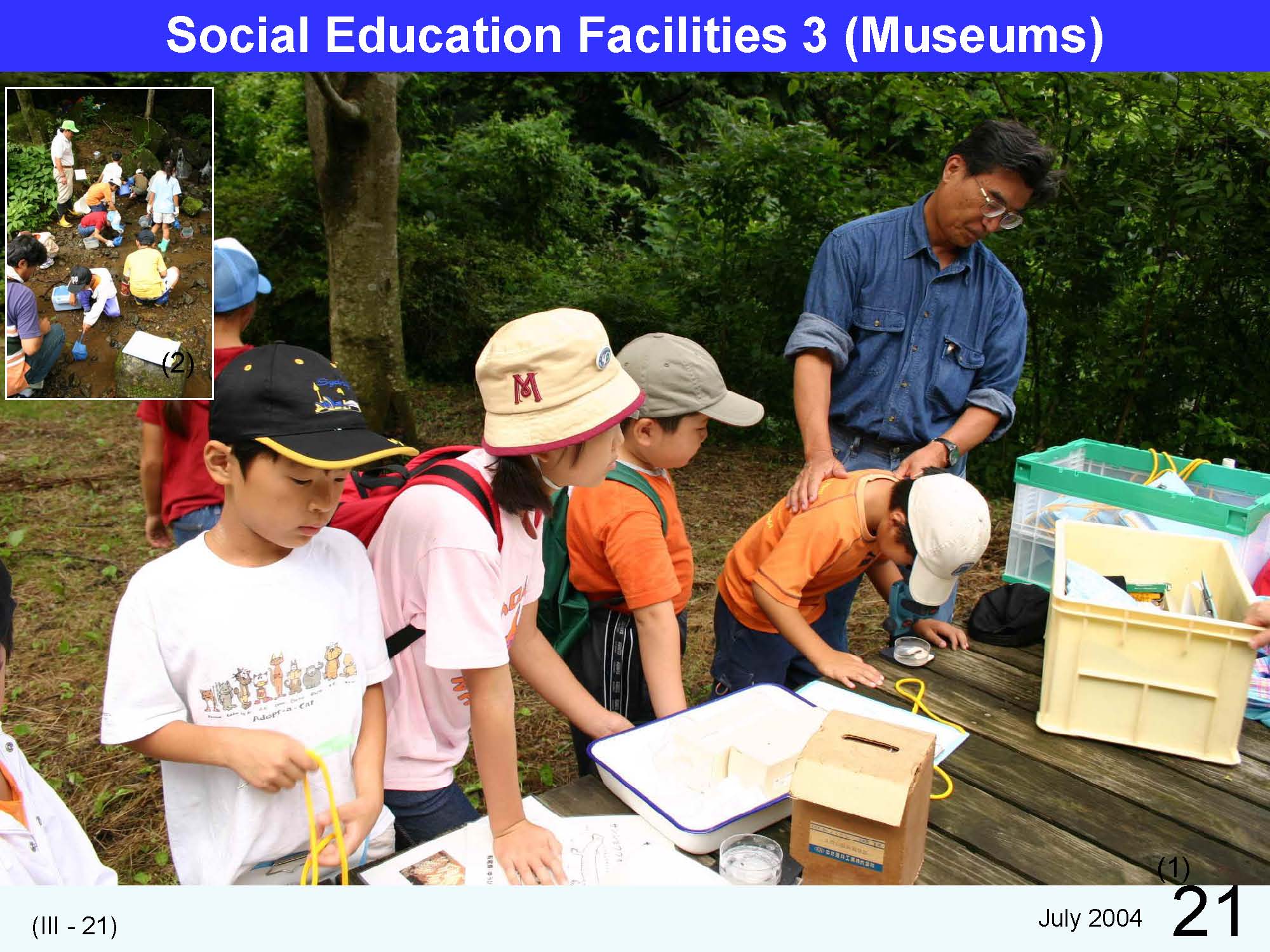 |
A natural museum offers various courses. This is a family nature observation course titled “the observation of Hakone salamanders. ” (1) Picking of Hakone salamanders, (2) Observation |
| 22 | 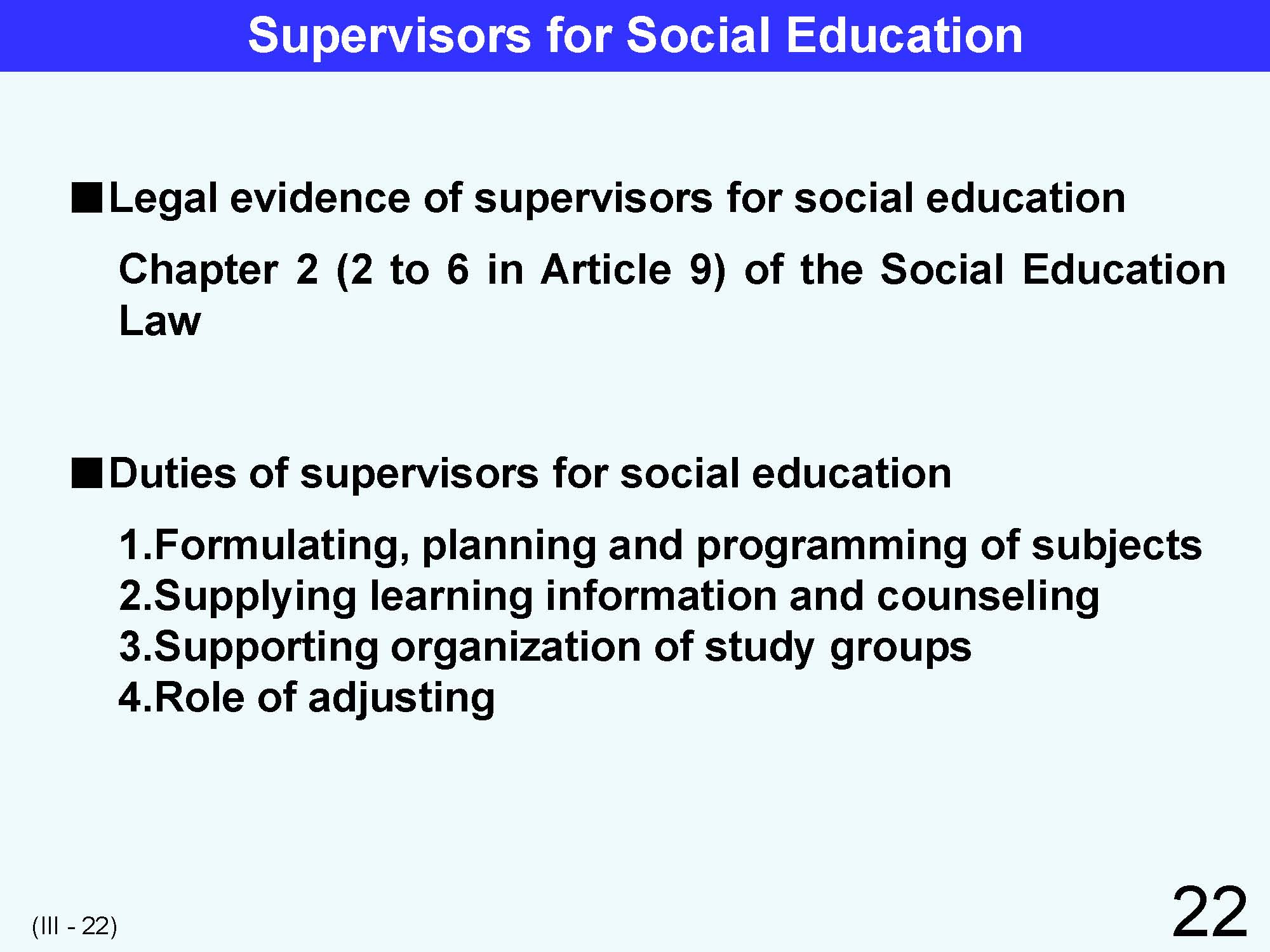 |
Supervisors for social education are professionals in social education. Duties are defined in the Social Education Law. Supervisors for social education are assigned to the secretariats of each board of education. Supervisors’ roles include planning social education, and coordinating interactions with other social education groups for social education projects. (Supervisor, Supervisor for social education-->Ⅱ-29) |
| 23 | 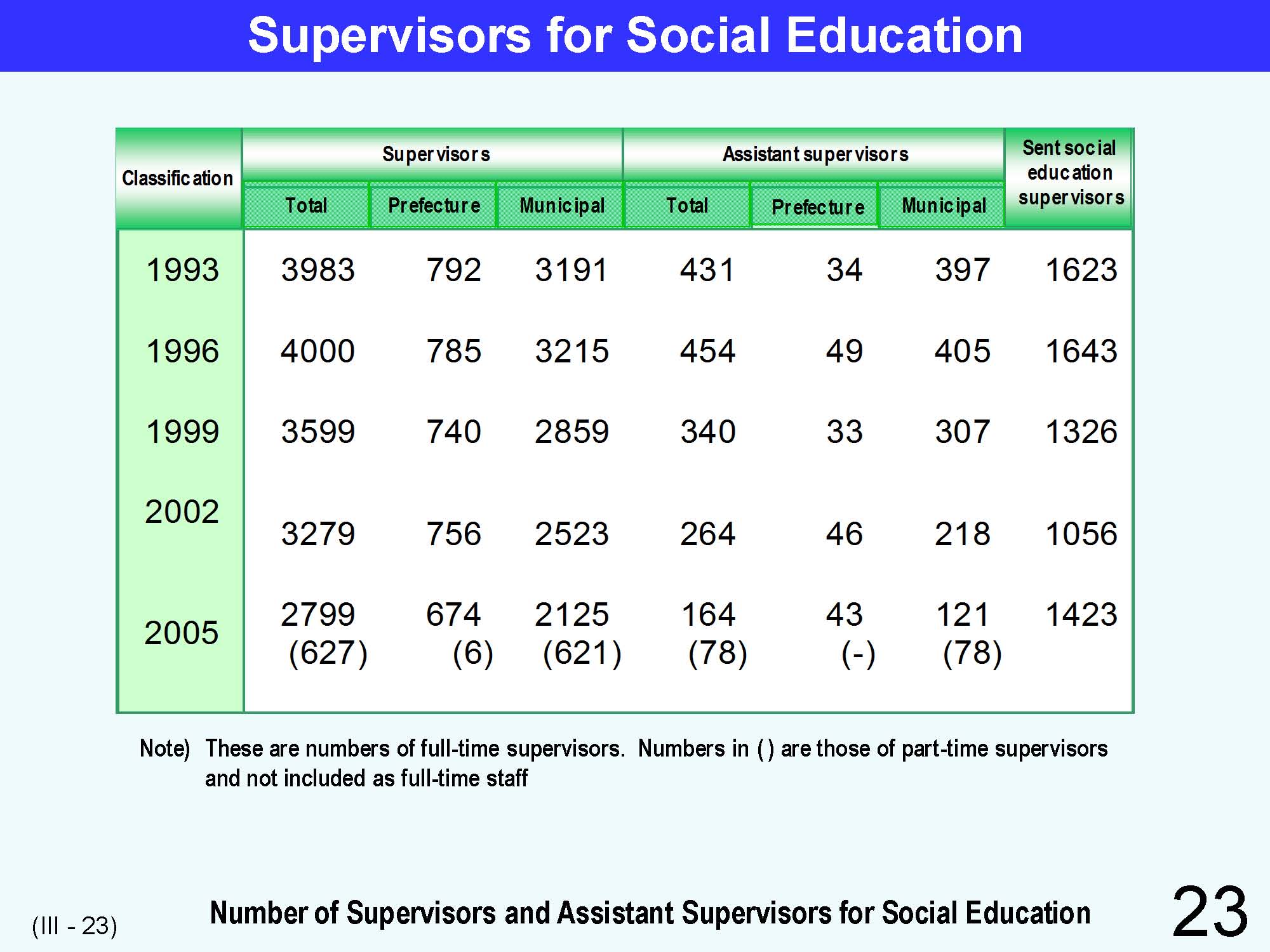 |
Supervisors for social education are full-time staff specialized in social education. Assistant supervisors for social education assist work of the supervisors and work during periods stipulated by the law. Persons are qualified to be supervisors if they have taken classes for subjects on social education. There were 4,599 supervisors and assistant supervisors in 2002. (These included visiting-supervisors for social education.) The system of visiting-supervisors for social education began in 1974 with a subsidy from the National Treasury in order to address the problem of a lack of supervisors for social education in some municipalities. |
| 24 | 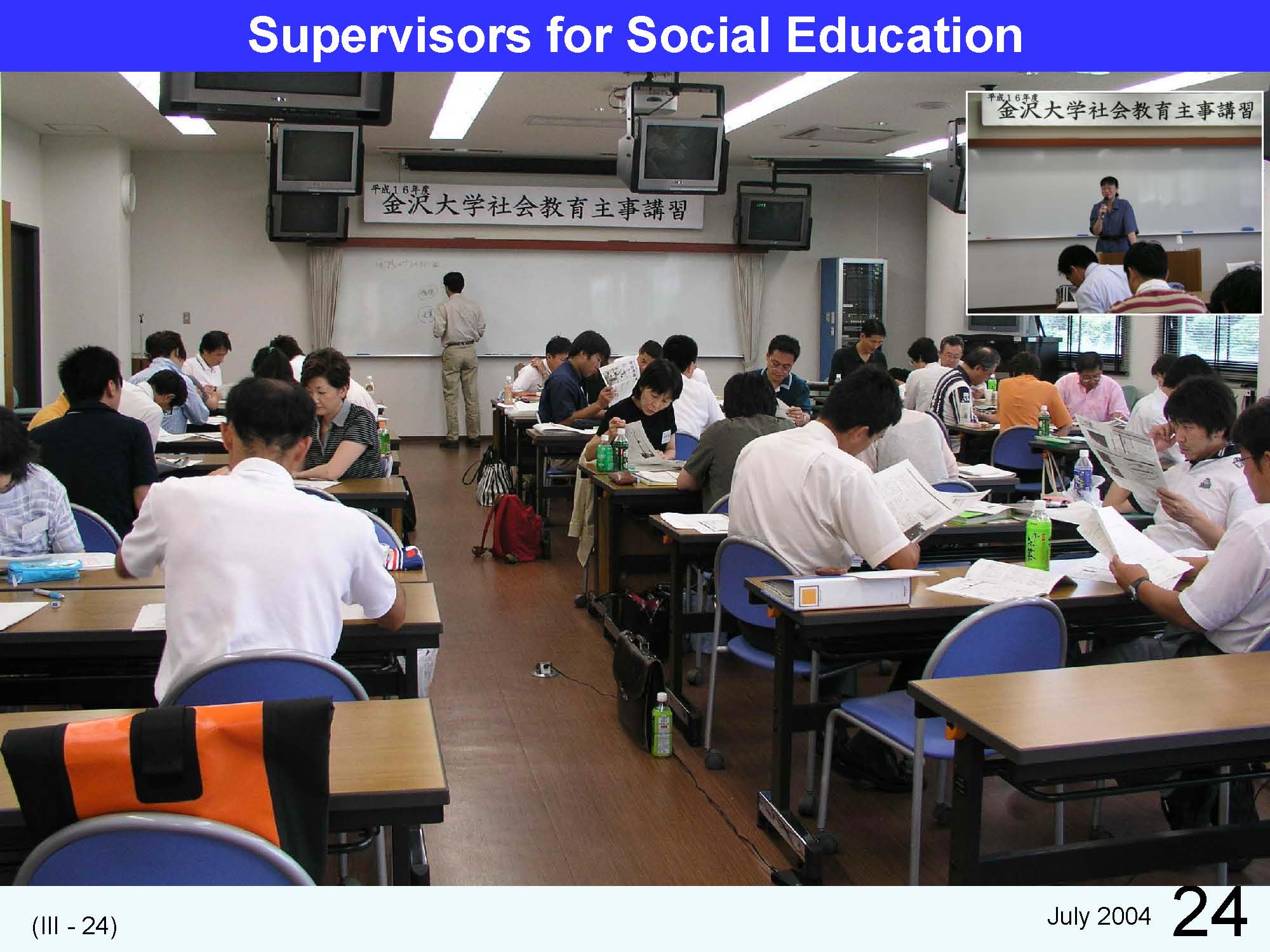 |
Picture: this lecture is offered by universities for people who want to become supervisors for social education held. |
| 25 | 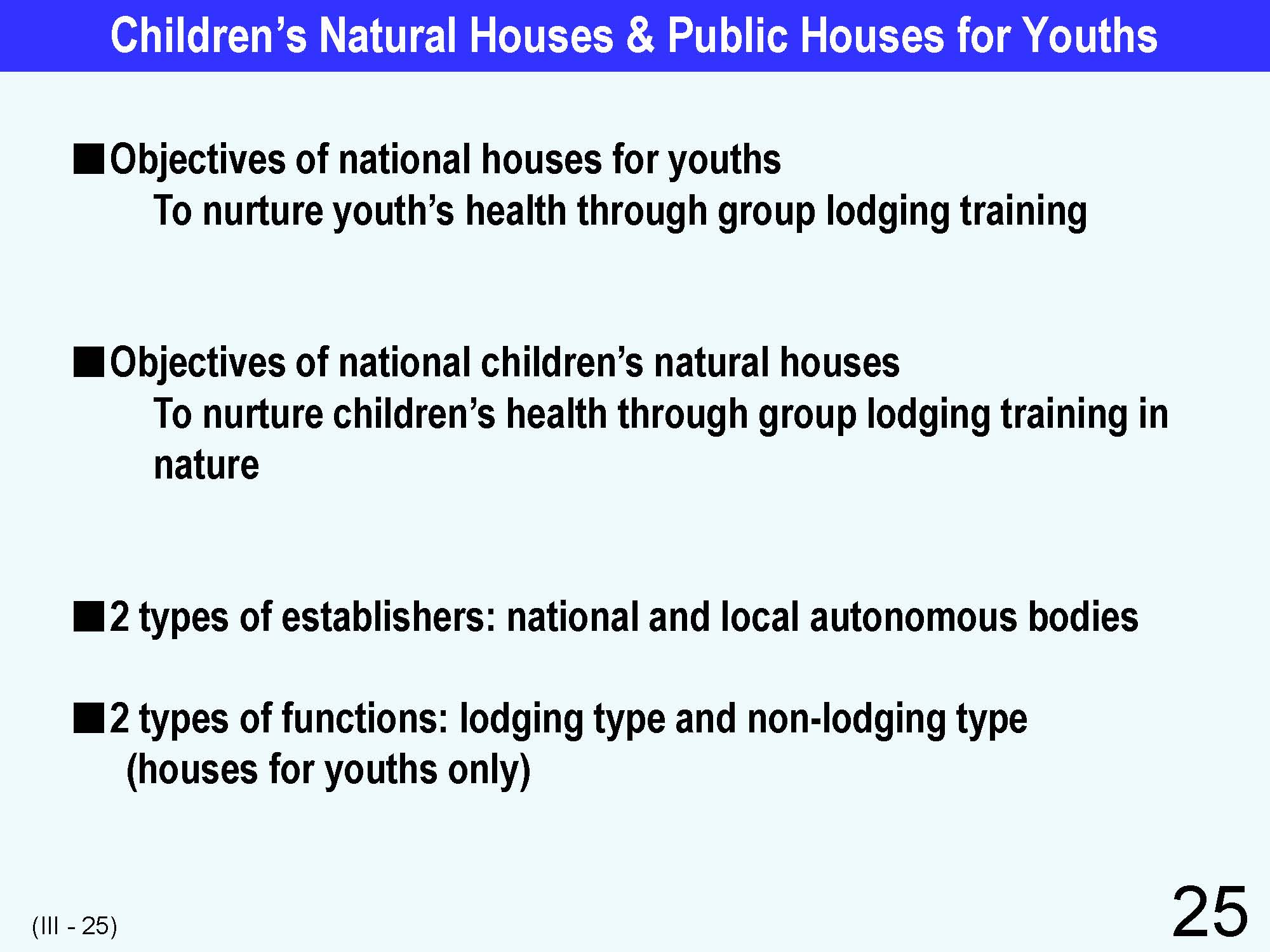 |
Houses for Youths and Children’s Natural Houses are social education institutions for youths and children. The number established increased especially after the 1970’s. In terms of types of establishers, there are national institutions as well as public institutions established by local autonomous bodies (municipalities). Also, in terms types of functions, there are lodgings located in remote areas and non-lodging facilities located in daily-life areas. In 1959, the Central House for Youth was established in Gotenba, Shizuoka as the first national house for youth, and 13 have been established up to the present. The first national children’s natural house was opened in 1975 in Muroto, Kochi, as the Muroto Children’s Natural House. Currently there are 14 children’s natural houses nationwide. At first,the lodging-type houses for youths and children’s natural houses focused on group lodging training. However, today, they allow small groups and families to use the facilities. From the perspective of supporting lifelong learning, these houses strengthen and support opportunities for independent activities by users. |
| 26 | 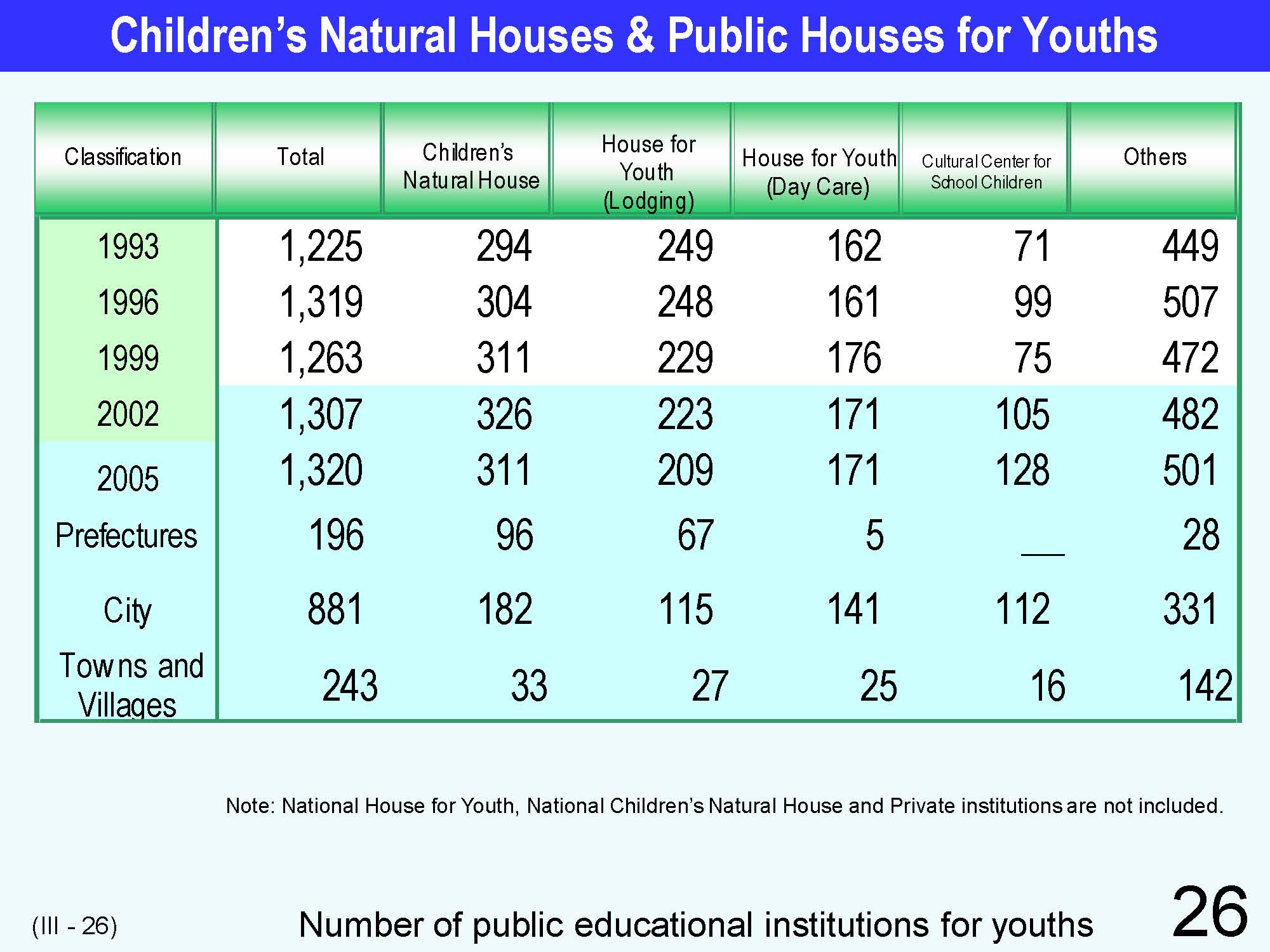 |
There were 1,320 public youth facilities in Japan as of 2005: 196 prefectural facilities (14.8%), 881 city (66.7%), and 243 town or village or union (18.4%) facilities respectively. According to their targets and functions, Children’s Natural Houses total 311 (23.6%), Houses for Youths (Lodging) total 209 (15.8%), Houses for Youths (Day Care) total 171 (13.0%), Cultural Centers for Children total 128 (9.7%), and other types of facilities total 501 (38.0%). |
| 27 | 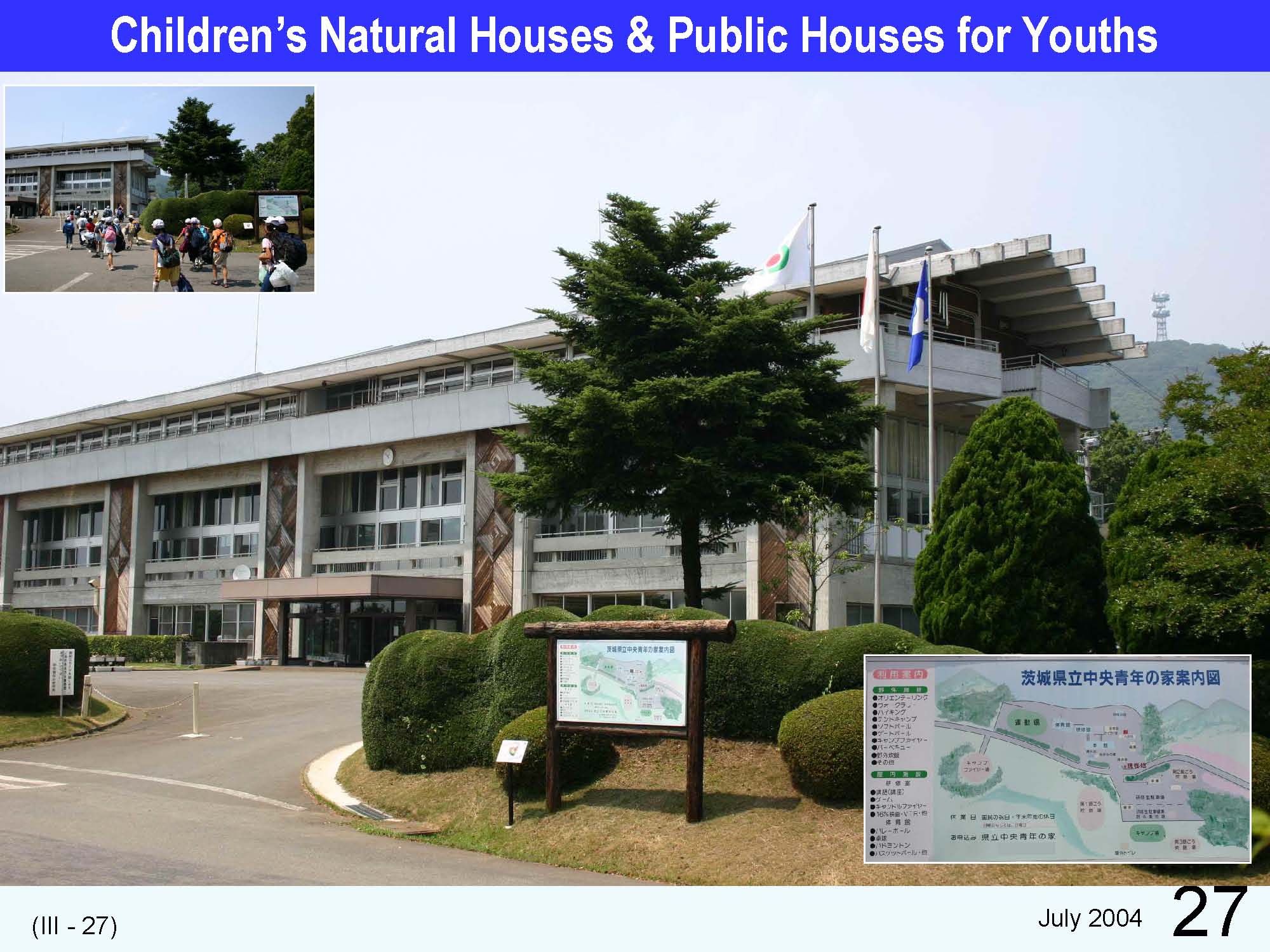 |
A Central Youth Center building in Ibaraki Prefecture |
| 28 | 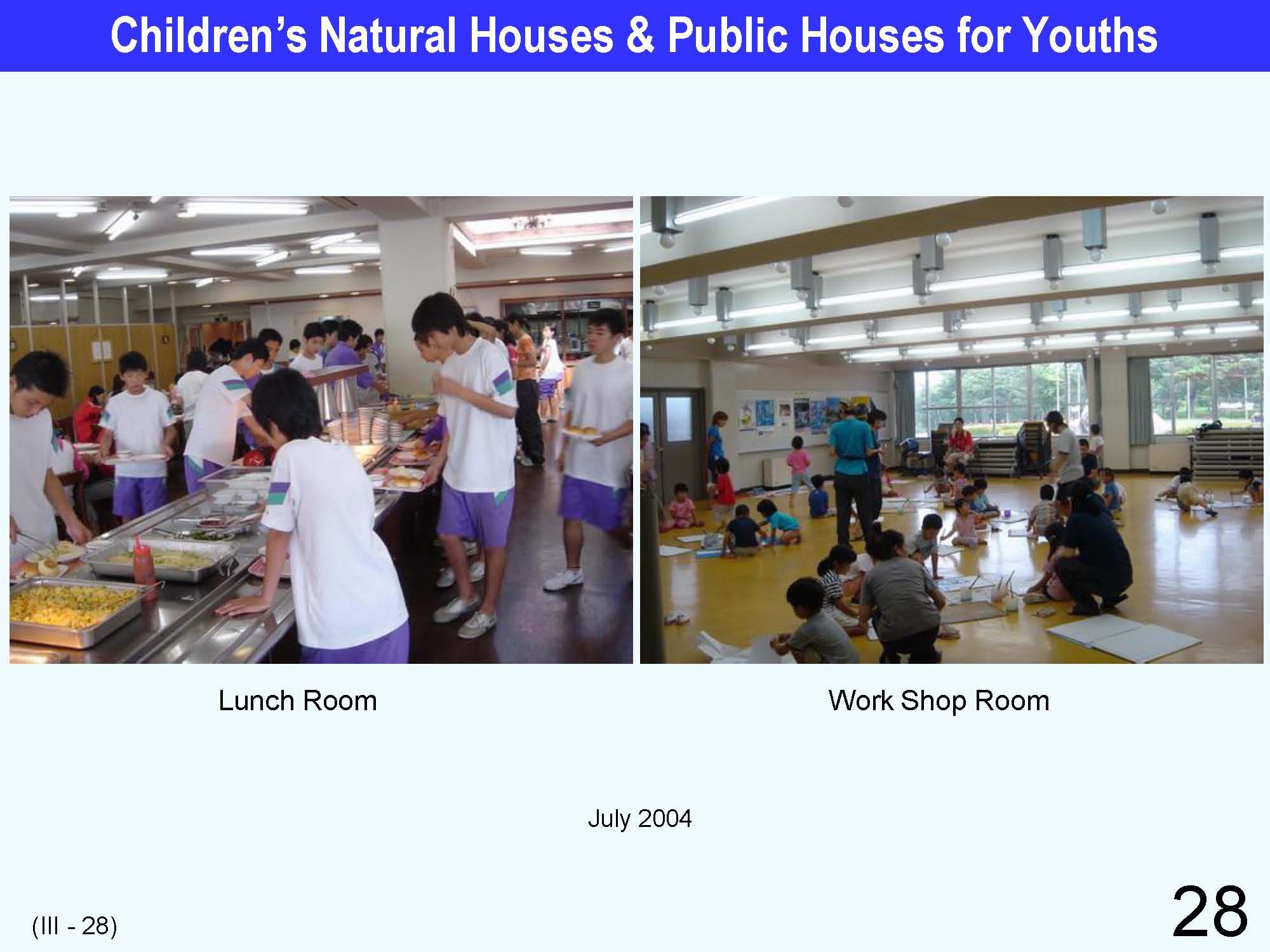 |
Inside facilities in a House for Youth |
| 29 | 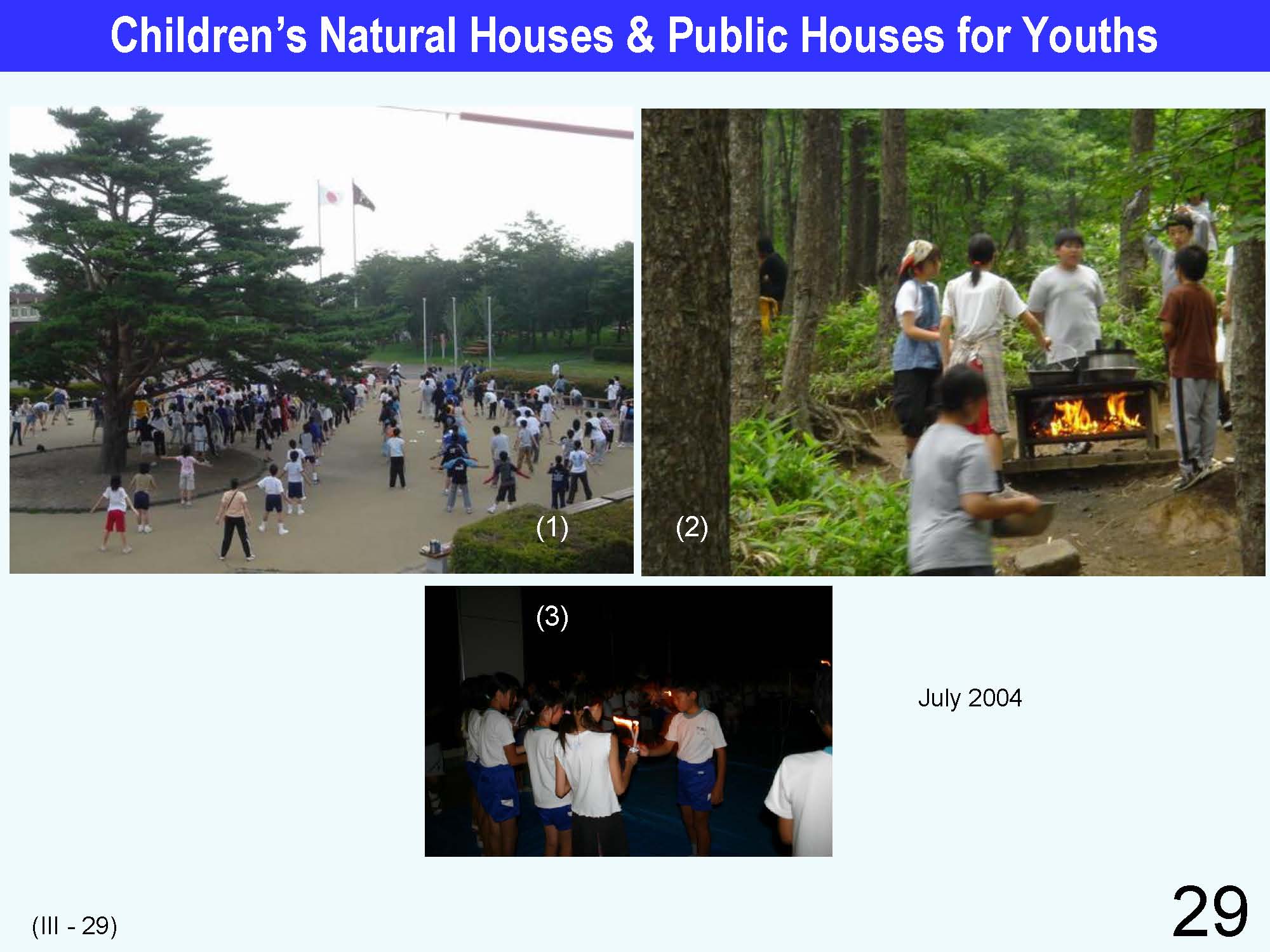 |
Various programs in the Houses for Youths. (1) Morning meeting (radio gymnastics) (2) Outdoor cooking (3) Candle performance |
| 30 | 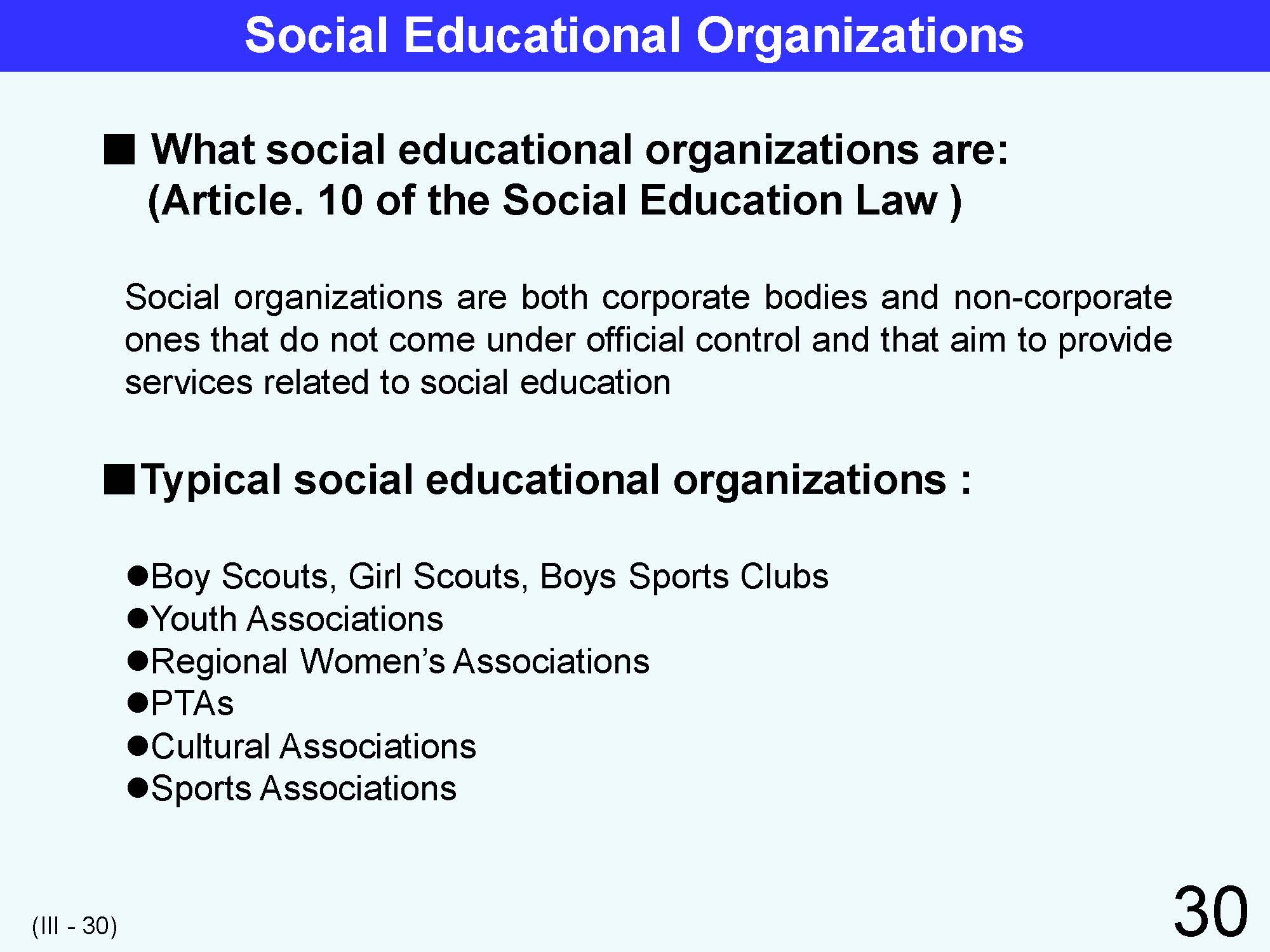 |
Social educational organizations are registered as organizations that “may be either corporate bodies o non-corporate ones that do not come under official public control and that aim to provide services related to social education” under the Social Education Law. Typical social educational organizations comprise PTAs, Culture Associations, Sports Associations, Boy Scouts, Youth Associations, Women’s Associations and Boys Sports Clubs. Social educational organizations are registered under the Social Education Law. This implies that there is a close relationship between Japanese social educational administration and social educational organizations. At the present, many regional bodies support diverse social educational organizations including learning (study) circles that are committed to activities in local communities. There is a need to structure a new relationship between social educational organizations and Japanese social educational administration considering the diversity of circles or clubs that are committed to local communities and NPOs that are committed to social education. |
| 31 | 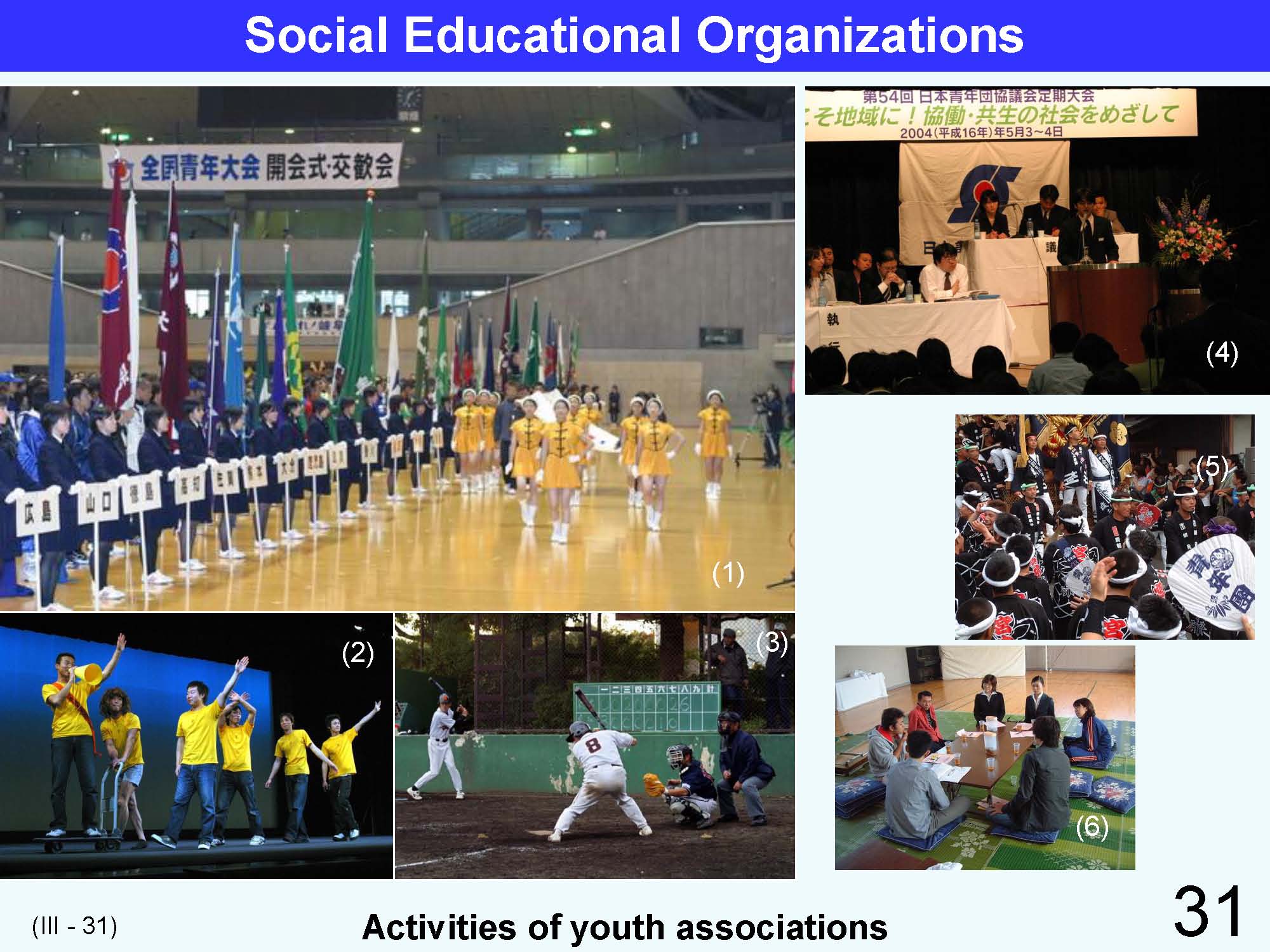 |
(1) (2) (3) National Youth Meeting, Nov. 2004 (4) Youth Association annual meeting, May 2004 (5) Regional activity: attendance at a local festival, 2003 (6) Regional activity: discussion about peace activities, 2003 |
| 32 | 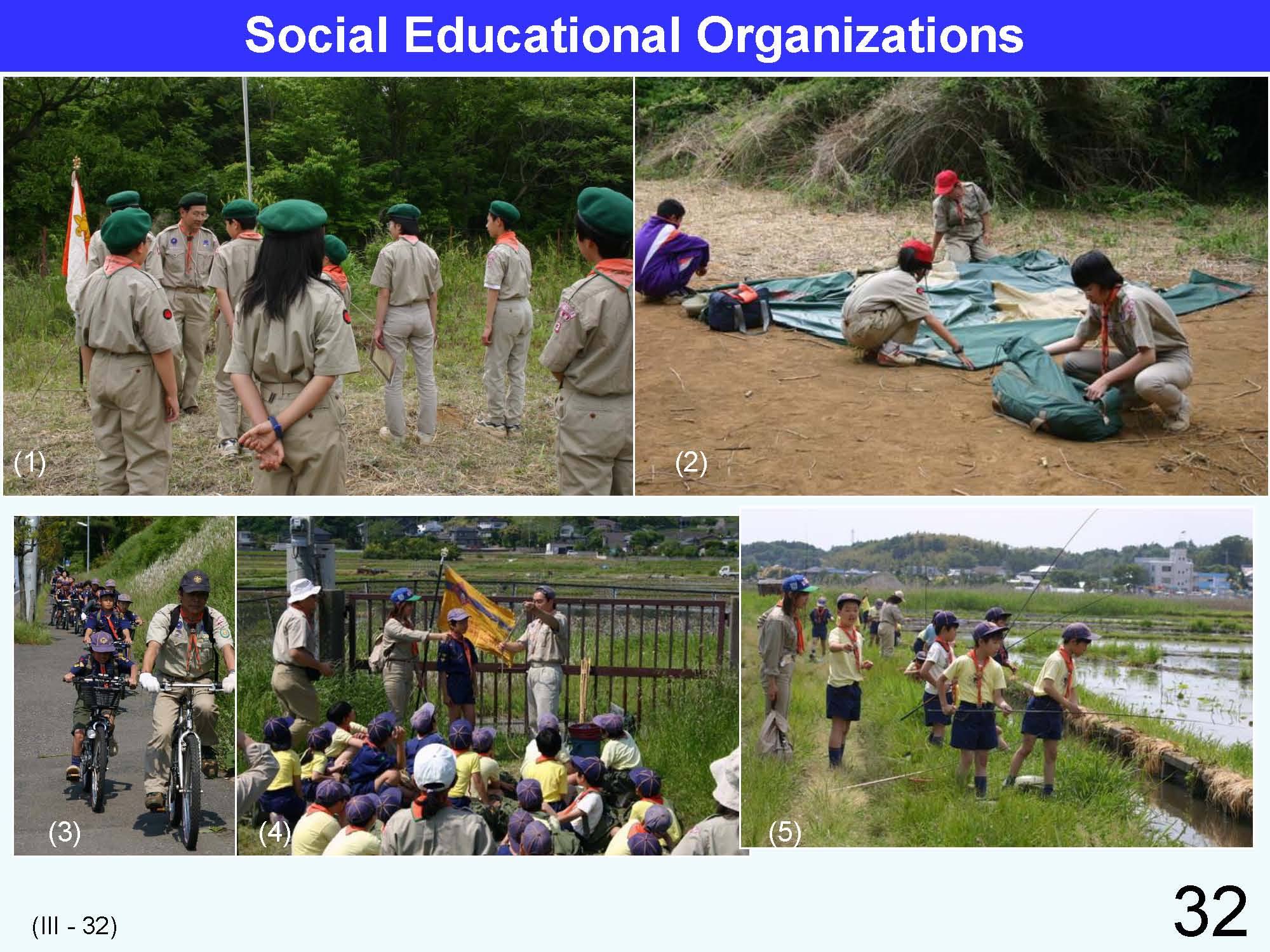 |
(1) (2) Boy Scouts’ activity: Camping (3) (4) (5) Cub Scouts’ activity: Fishing |
| 33 | 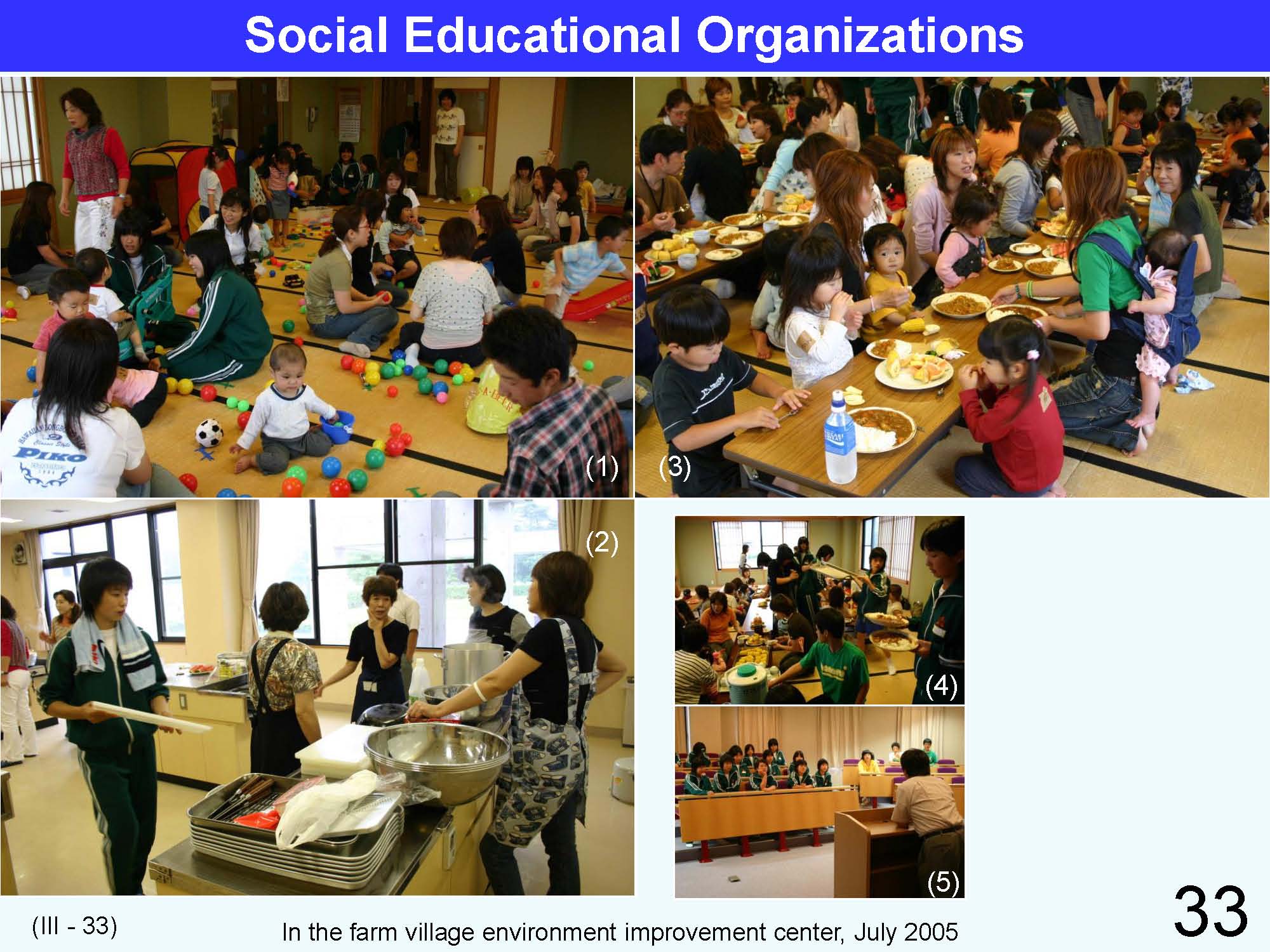 |
This regional Women’s Association holds a convivial meeting every month inviting mothers/lower secondary school students/members of this association as a type of activity to assist parenting mothers ((1)-(5)). There are 108 members of the association. All activities are carried out based on membership fees (1,000yen/year) and other income sources, for example selling vegetables and foods. (1) Mothers enjoy themselves talking with other participants while their babies and children are playing. (2) Some members and lower secondary school students are cooking for lunch. (3) The meeting closes after taking lunch. Many mothers join in even though they are not association members. (4) Lower secondary school students take part as volunteers to support this activity for parenting mothers. (5) A supervisor for social education from the townhouse lectures lower secondary school students in order to train them as rural junior leaders. |
| 34 | 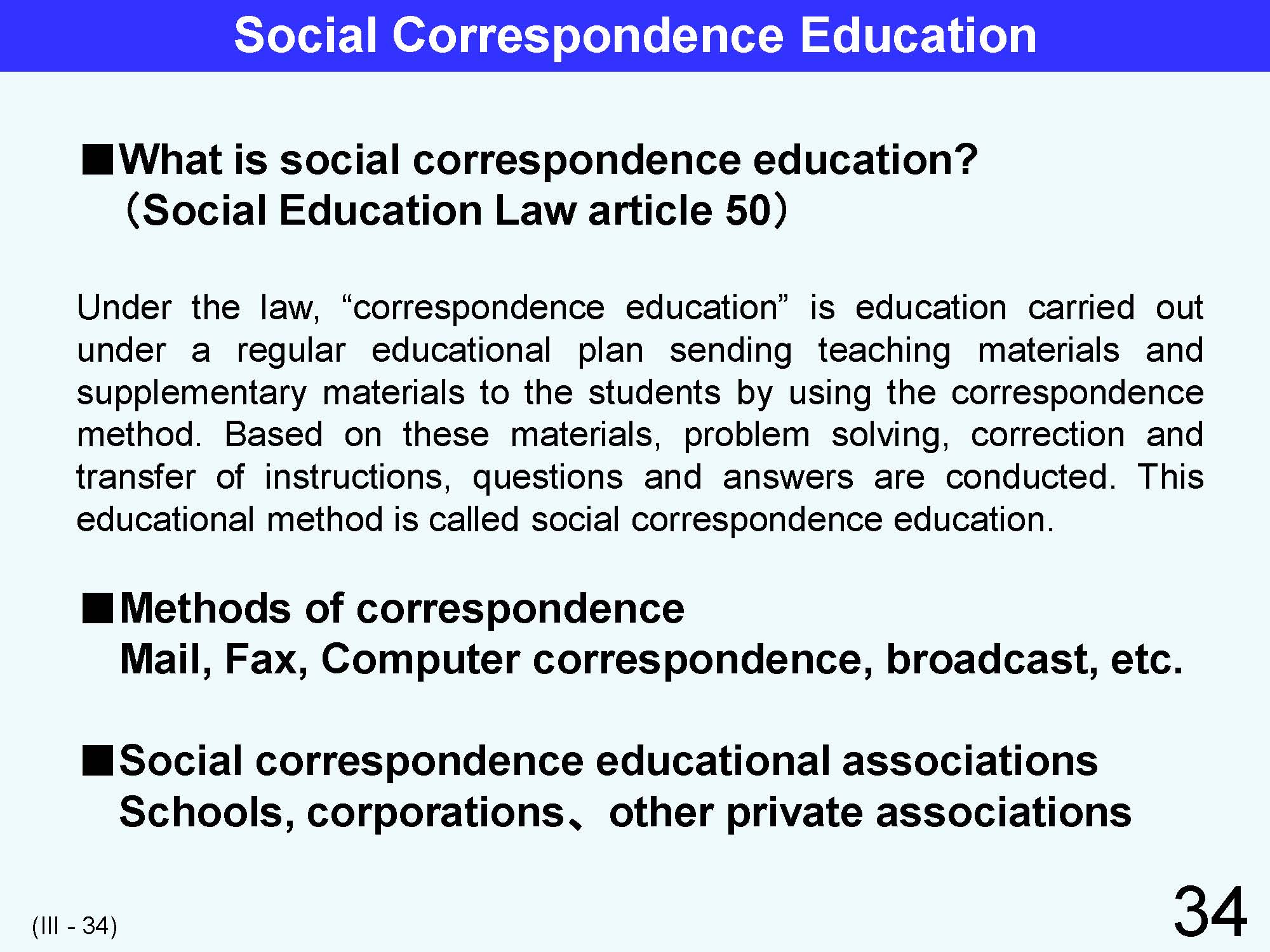 |
Under the Social Education Law, correspondence education is approved when conducted using regular educational plans, involving sending of teaching materials and supplementary materials to students through the correspondence method. Based on these materials, students solve problems, teachers make corrections and give instructions, and questions and answers are corresponded. (Article 50) The major correspondence methods and mediums comprise mail, fax, computers, broadcasts, and other types. By using these methods, videos and sound materials can be used efficiently. For evaluation purposes, social correspondence education should be associated with schools and vocational training institutions. There are four types of correspondence courses : 1) qualifications, 2) business, 3) hobby・language and 4) liberal arts. |
| 35 | 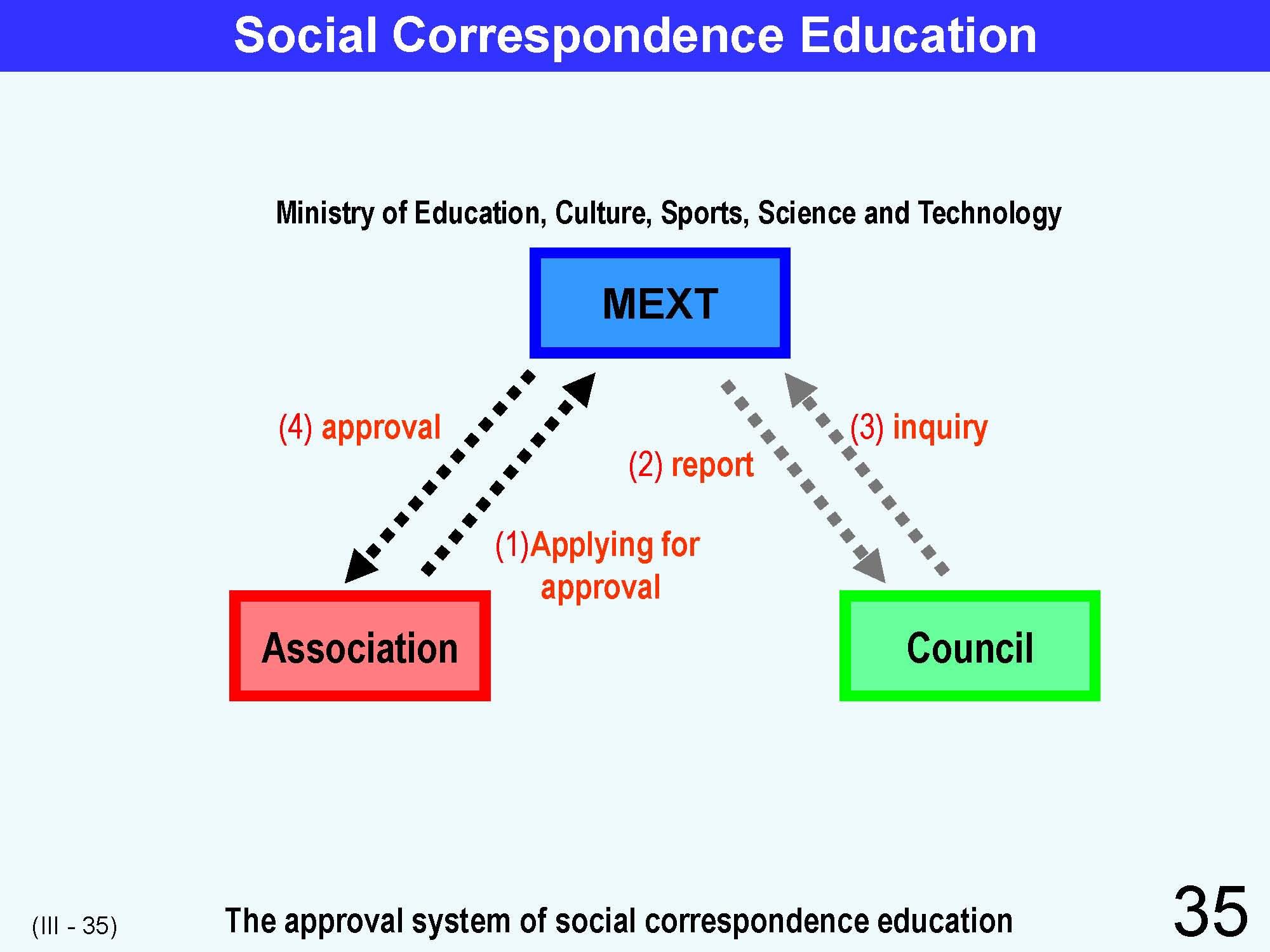 |
Bodies or associations which intend to start social correspondence educational programs (schools or public corporations that are non-profit organizations such as foundations) apply for approval and authorization through the Ministry of Education, Culture, Sports, Science and Technology. The Ministry judges their financial ability to undertake the correspondence education business, the appropriateness of the contents of their teaching materials and correction and guidance, and the adequacy of the number of teaching advisors available. MEXT then decides whether such correspondence courses are needed to encourage and promote social education and then authorizes the courses. |
| 36 |  |
A social welfare course held by a corporate body contains home-study/schooling/practice teaching, and is completed in two years. The recruitment number is 2,000 persons every year, with 21,600 persons having passed through this course. (1) Schooling in a social welfare course: A lecture titled the introduction of social education, Nov 2004 (2) A practical guide for teaching of nursing care |
| 37 | 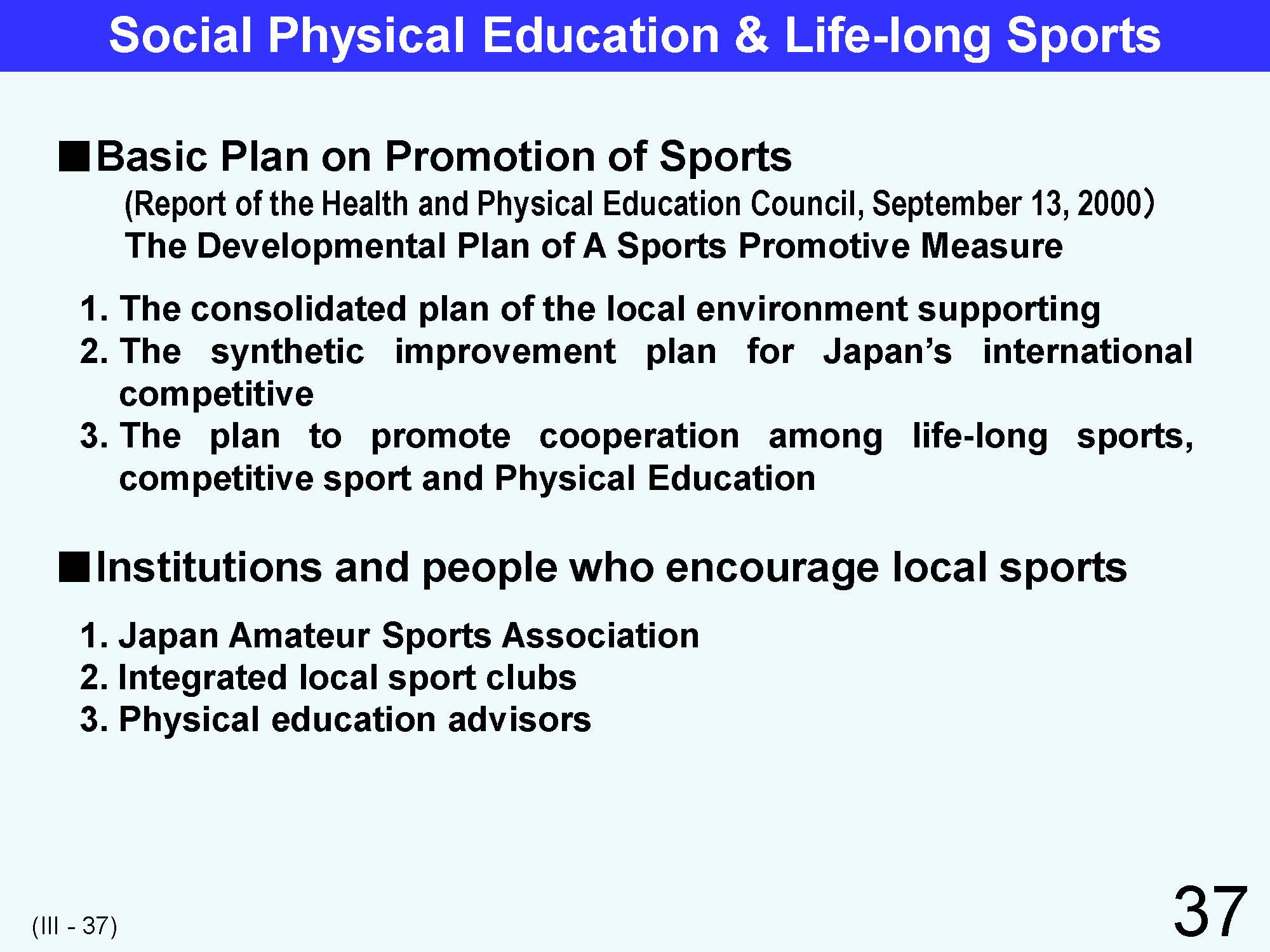 |
In recent years, there have been increasing numbers of people who participate in sports in daily life to the accompaniment of expanding interests in sports, increasing leisure time and improvements in the standard of living in Japan. MEXT attempts to consolidate local sports environments with the objective to promote a life-long sports society In Japan that allows every citizen to enjoy sports and to improve physical abilities. The idea is based on the “Basic Plan for Promotion of Sports”, that was enunciated in September 2000 as a 10-year plan starting from 2001. Currently, the state provides assistance to establish integrated sports clubs and to promote sport centers that service wide areas where people can gain familiarity with sports and where the training of sport instructors can be conducted. By this measure the state attempts to promote sports in the wider society including staging of sports events. |
| 38 | 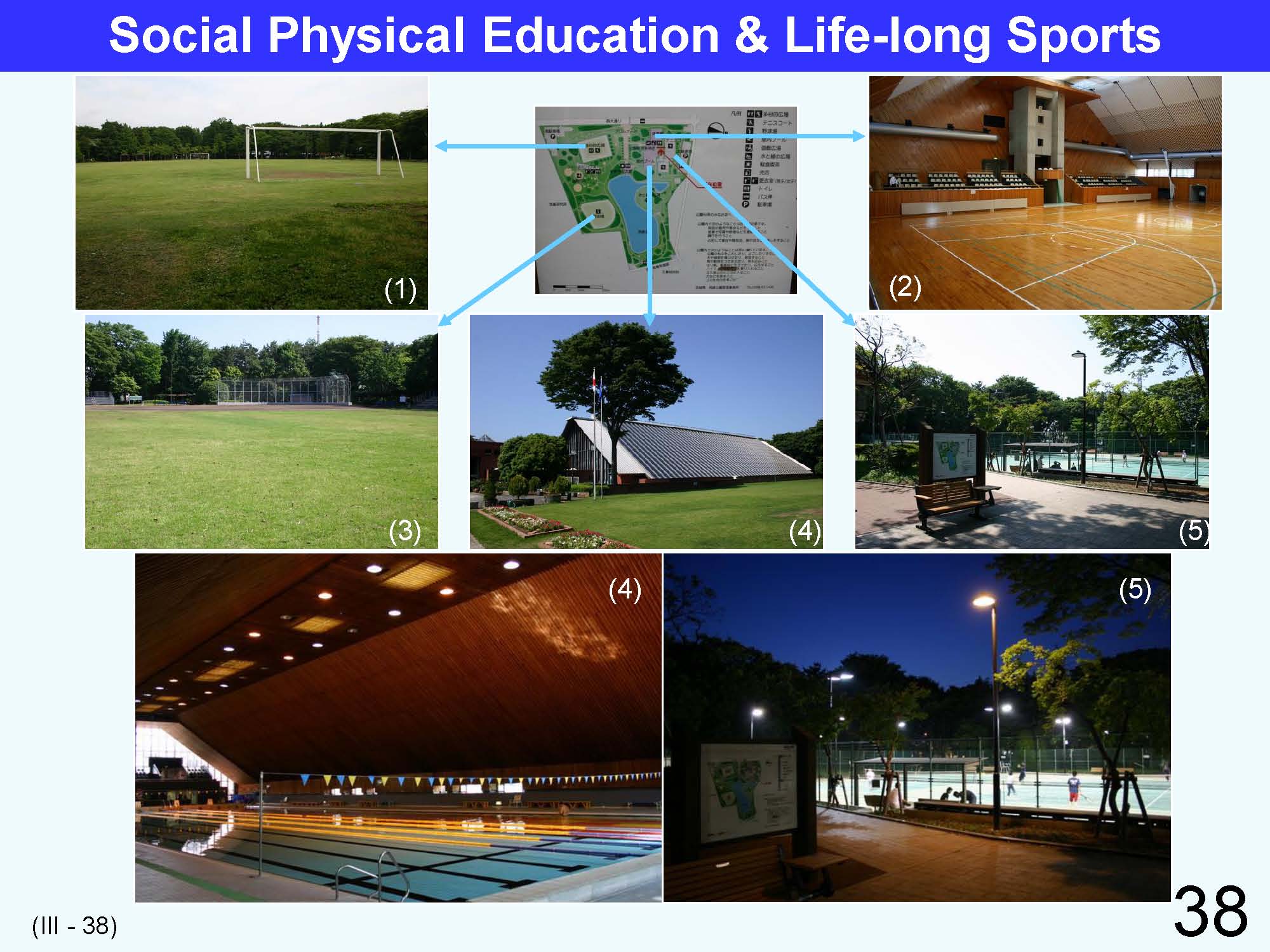 |
Prefectural park (1) Multi-purpose area (2) Gymnasium (3) Baseball ground (4) Indoor pool (5) Tennis court |
| 39 | 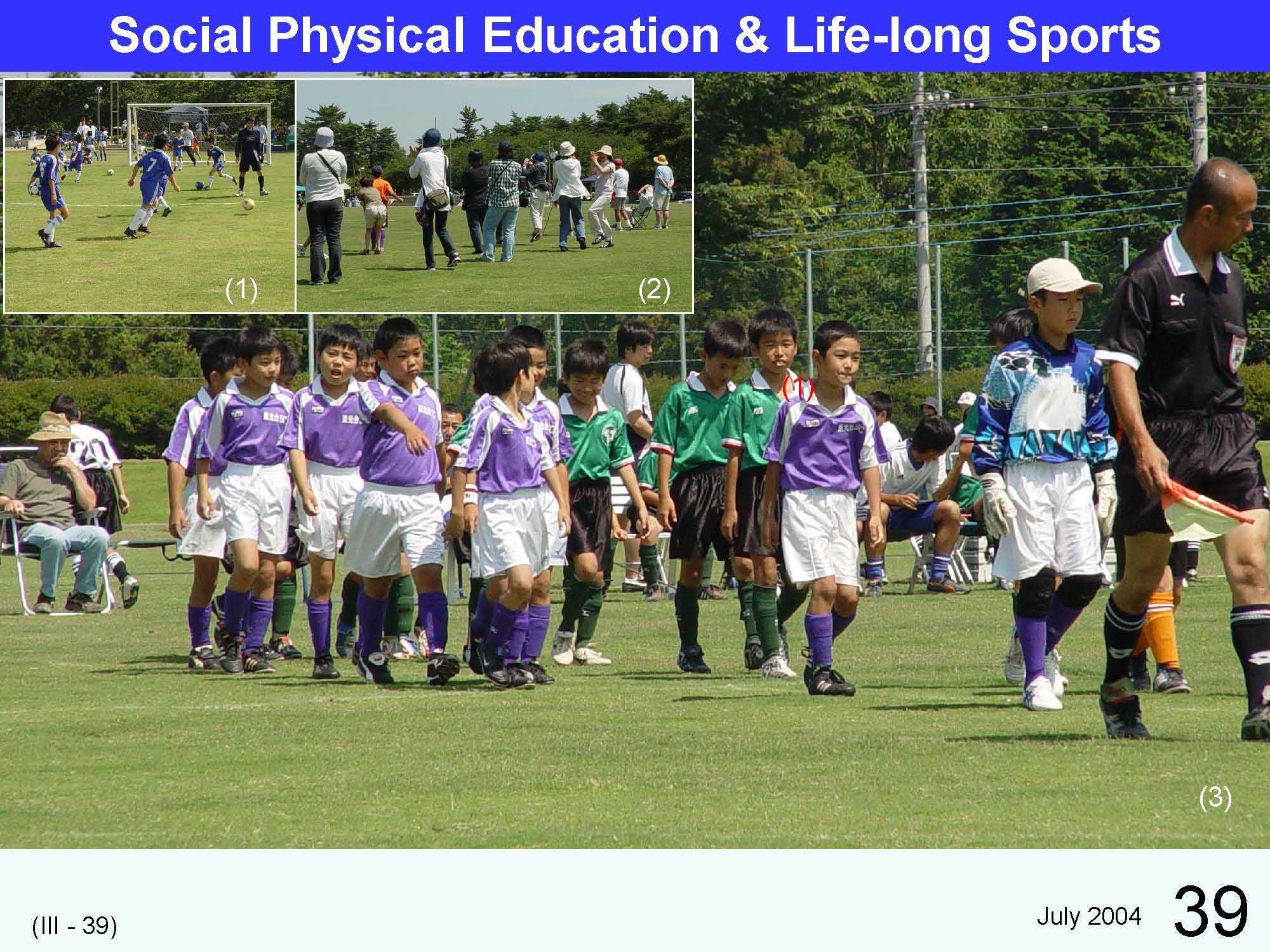 |
Soccer festival for lower grades of an elementary school at a soccer field in municipal sports park (July, 2004) [Example] (1) Warming up and exercise, (2) Cheering families、 (3) Game A rental fee for a multi-purpose area at this place: whole space = 3000 yen for 2 hours for 2 soccer fields The number of registered boys sport clubs in Tsukuba city. Baseball 19 clubs - 434 members (students), 140 instructors Soccer 20 clubs - 969 members (students), 128 instructors Judo 4 clubs - 71 members (students), 10 instructors |
| 40 | 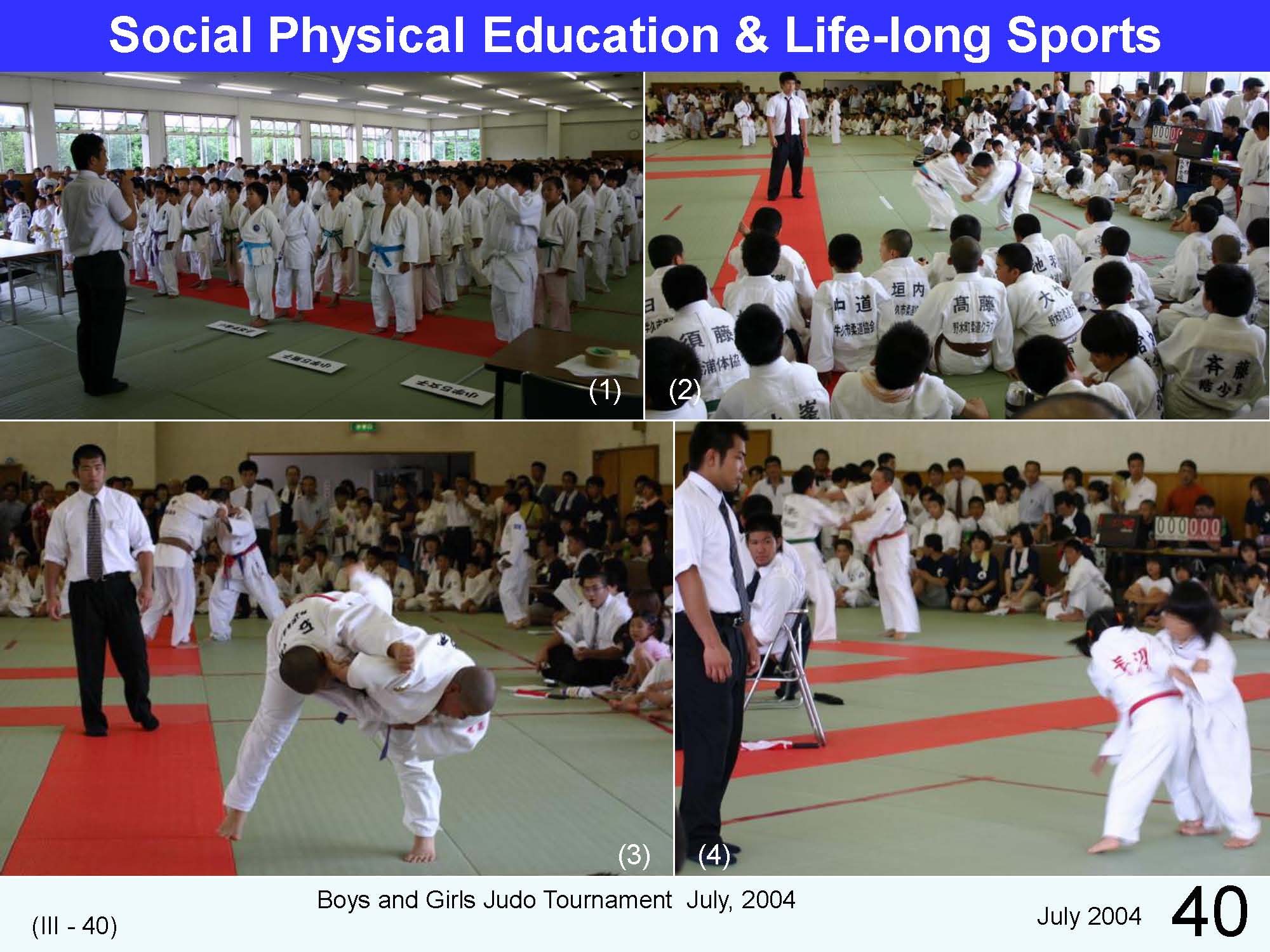 |
The 5th Tsukuba Boys and Girls Judo Meeting (Sponsorship: Tsukuba City Board of Education and Judo club of the University of Tsukuba; Meeting Place: Martial Arts Hall, University of Tsukuba) (1) Opening ceremony (2) (3) (4) Judo matches |
| 41 | 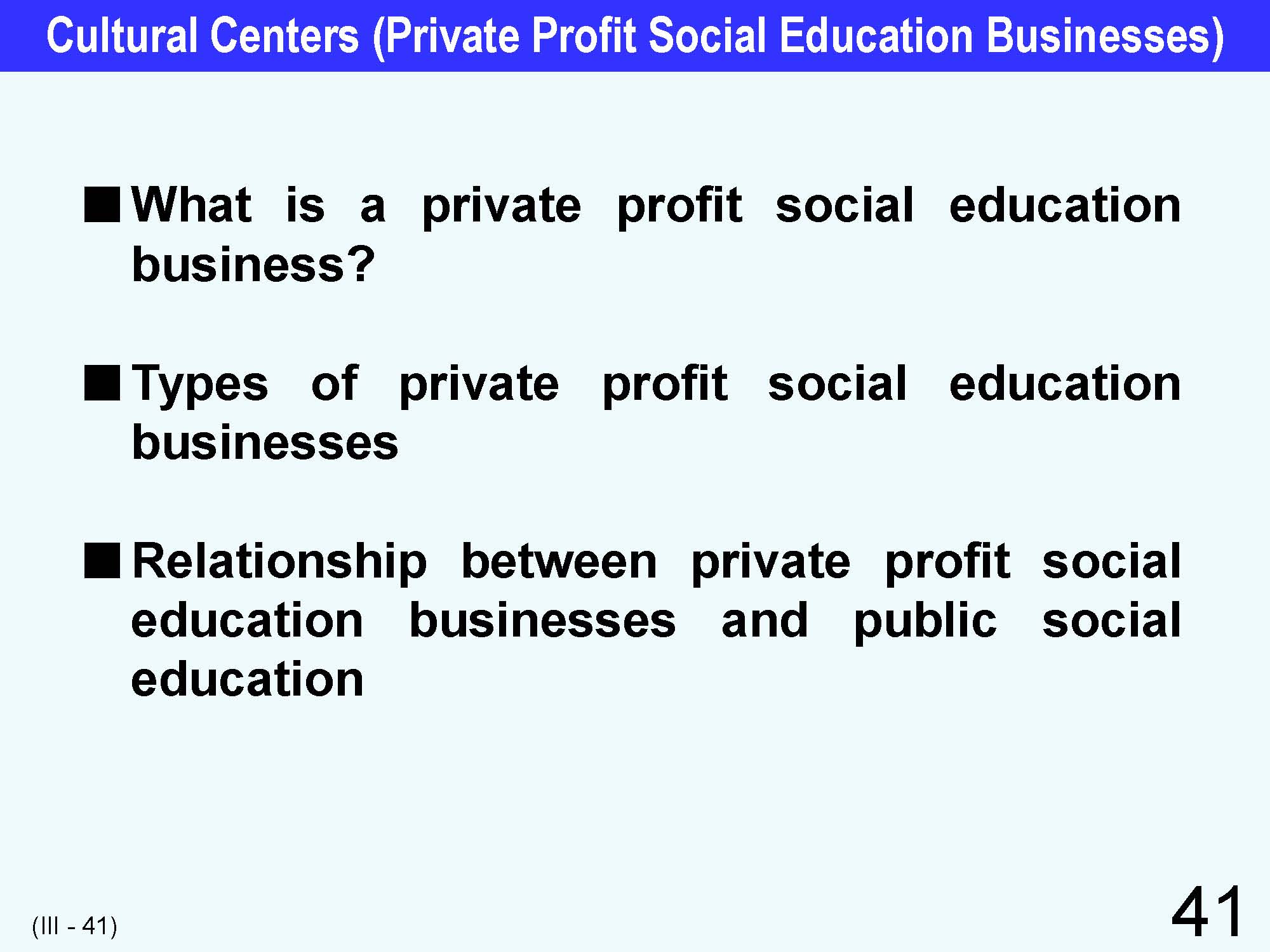 |
Recently, especially in urban areas, private companies such as newspaper firms, broadcasters, or department stores, have opened cultural centers to provide opportunities for education, culture, and sports businesses (courses) to the public with a charge. Private social education businesses such as cultural centers offer diverse and creative learning opportunities with flexible ideas. Although they differ in degree between regions, private social education businesses play extremely important roles in supporting diverse lifelong learning activities for residents. Under the notice by the head of the lifelong learning department of MEXT, “Interpretations regarding private profit social education businesses in the Social Education Law” issued in September, 1995, MEXT announced its view that “social education” defined in Article 2 of the Social Education Law includes organized educational activities by private businesses and the use of citizens’ public halls by private profit social education businesses. |
| 42 | 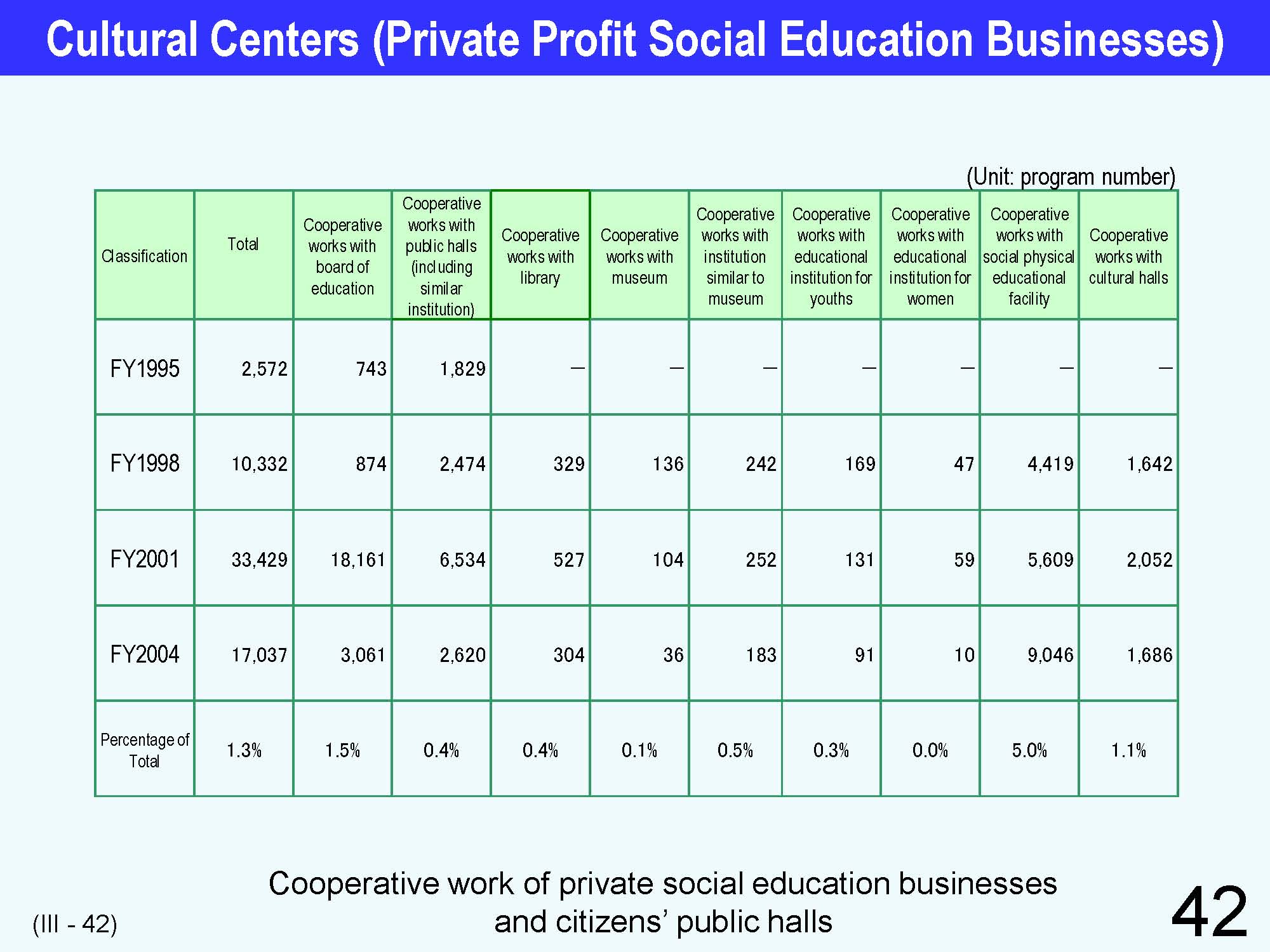 |
Although there had been steady growth in the total number of cooperative works of private profit social education businesses by FY2003, cooperative works with each entity were decreasing except the one with social physical education facilities. Above all, there was marked decline in the number of cooperative works with boards of education. Cooperative work of private profit education businesses and social physical educational facilities made up 5 % of the total number of works at social physical educational facilities in FY2004. |
| 43 | 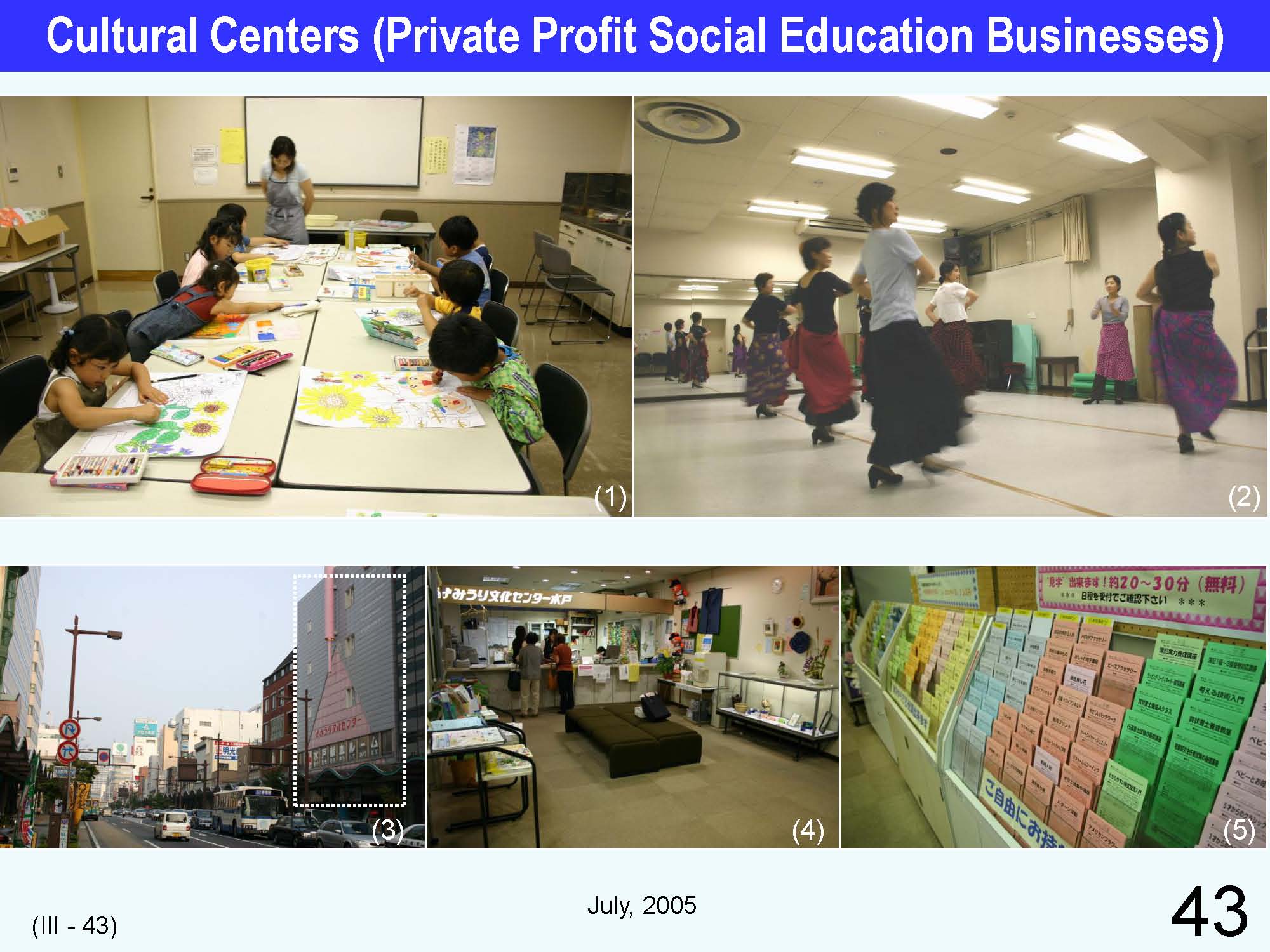 |
(1) Children’s atelier course (2) Flamenco course (3) This cultural center which is located in a downtown area is administrated by a newspaper company. (4) Front of this cultural center. Every course will finish in 3 months. The center prepares 230 courses and about 1,000 persons are taking courses. The proportion of females who take courses is more than 80%, and the proportion of female lecturers is more than 70%. Among the elderly, higher numbers of males take courses. (5) Leaf lets of various courses: courses concerning obtaining qualifications, languages, playing instruments, dances, health, cooking, general knowledge, and hobbies |
| TOP | ||
Please send your comments and concerns here
kamada@criced.tsukuba.ac.jp
Center for Research on International Cooperation in Educational Development (CRICED) University of Tsukuba
1-1-1, Tennodai, Tsukuba-shi, IBARAKI
305-8572 JAPAN